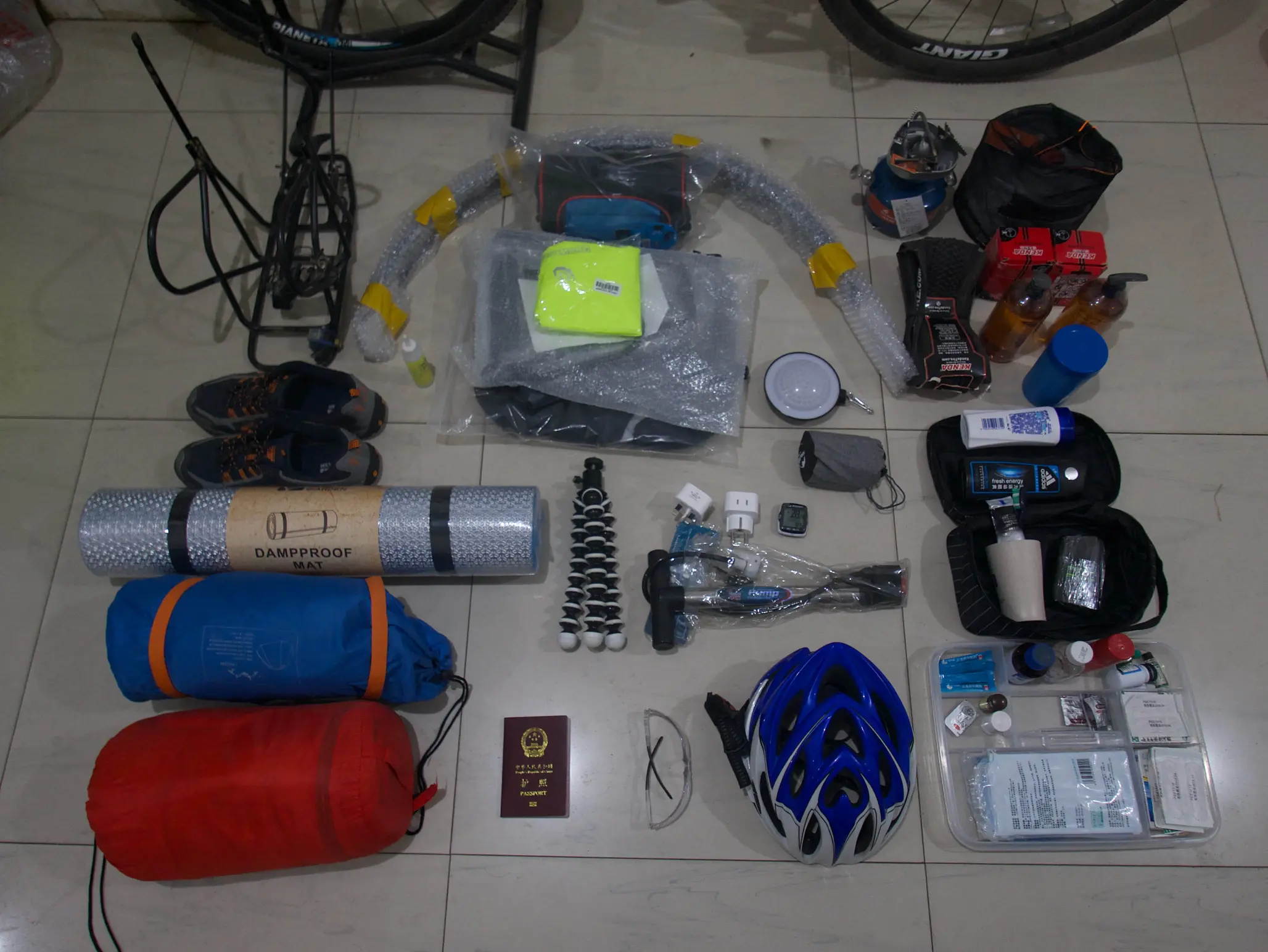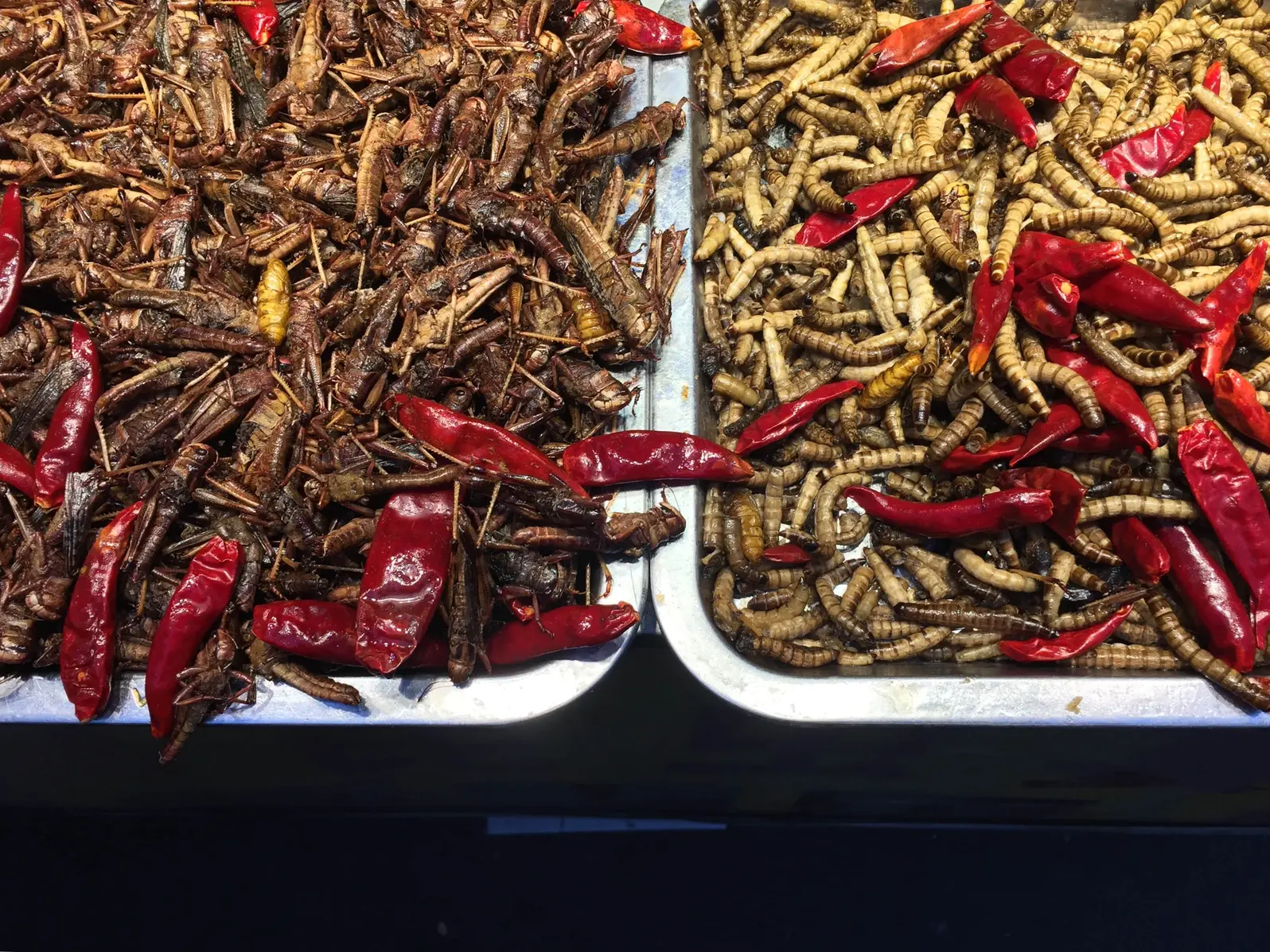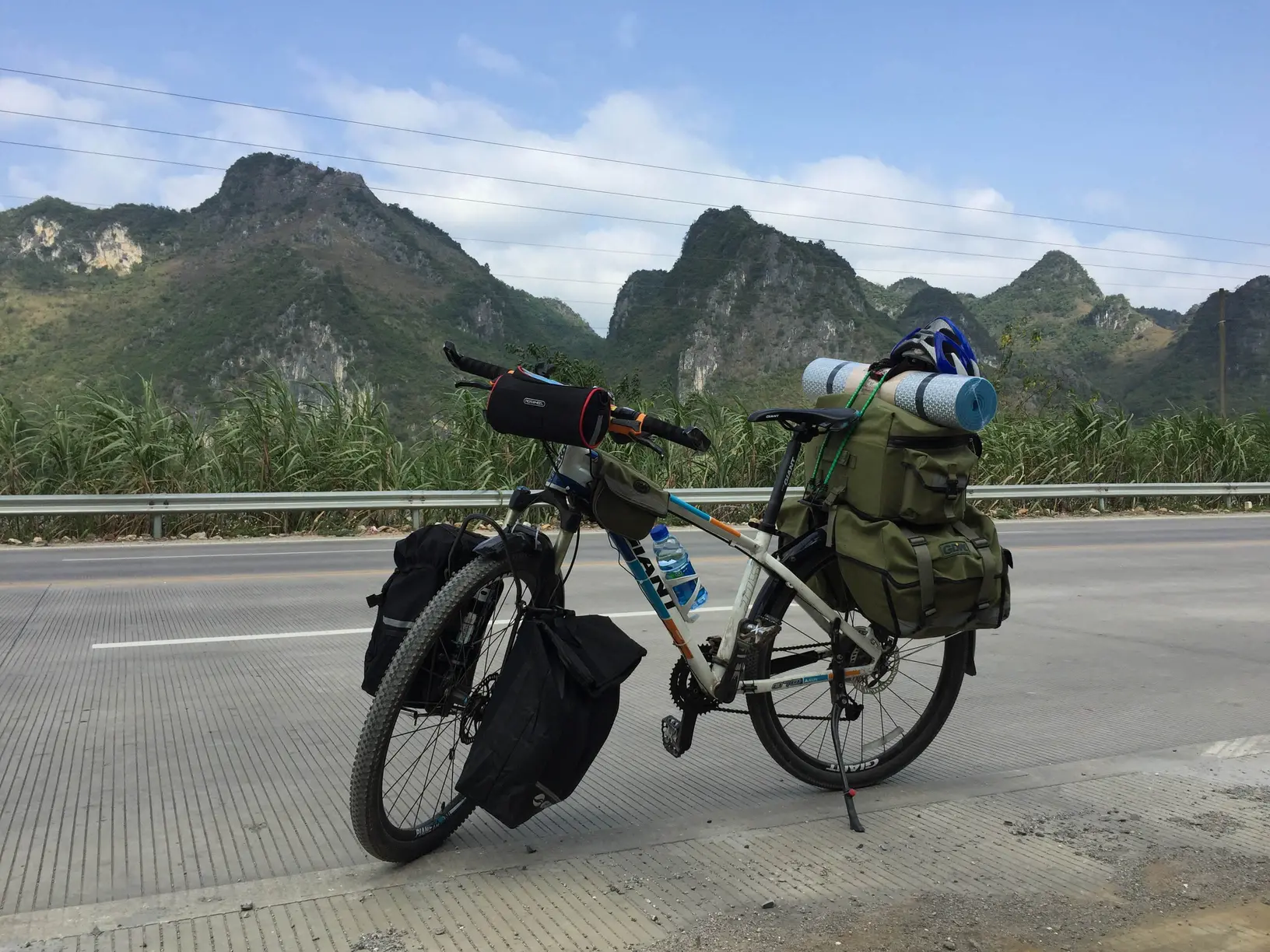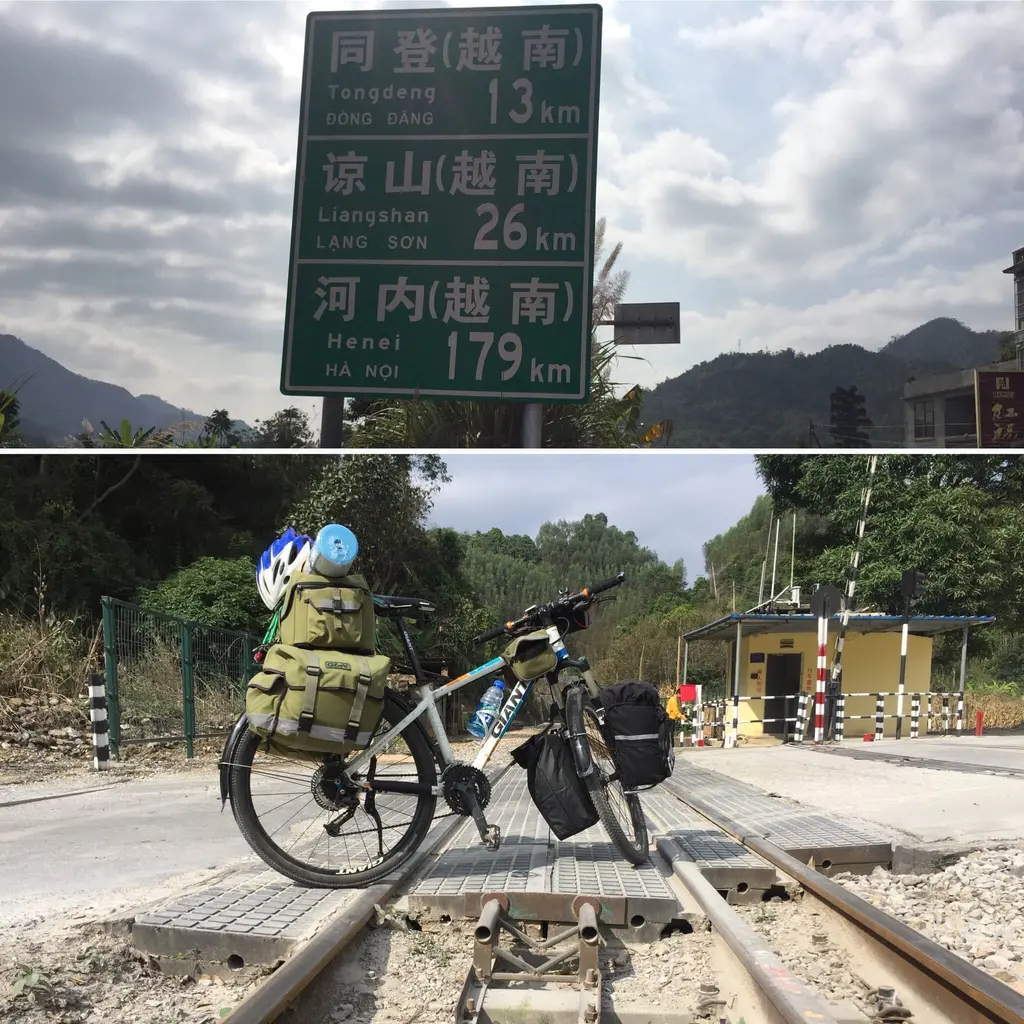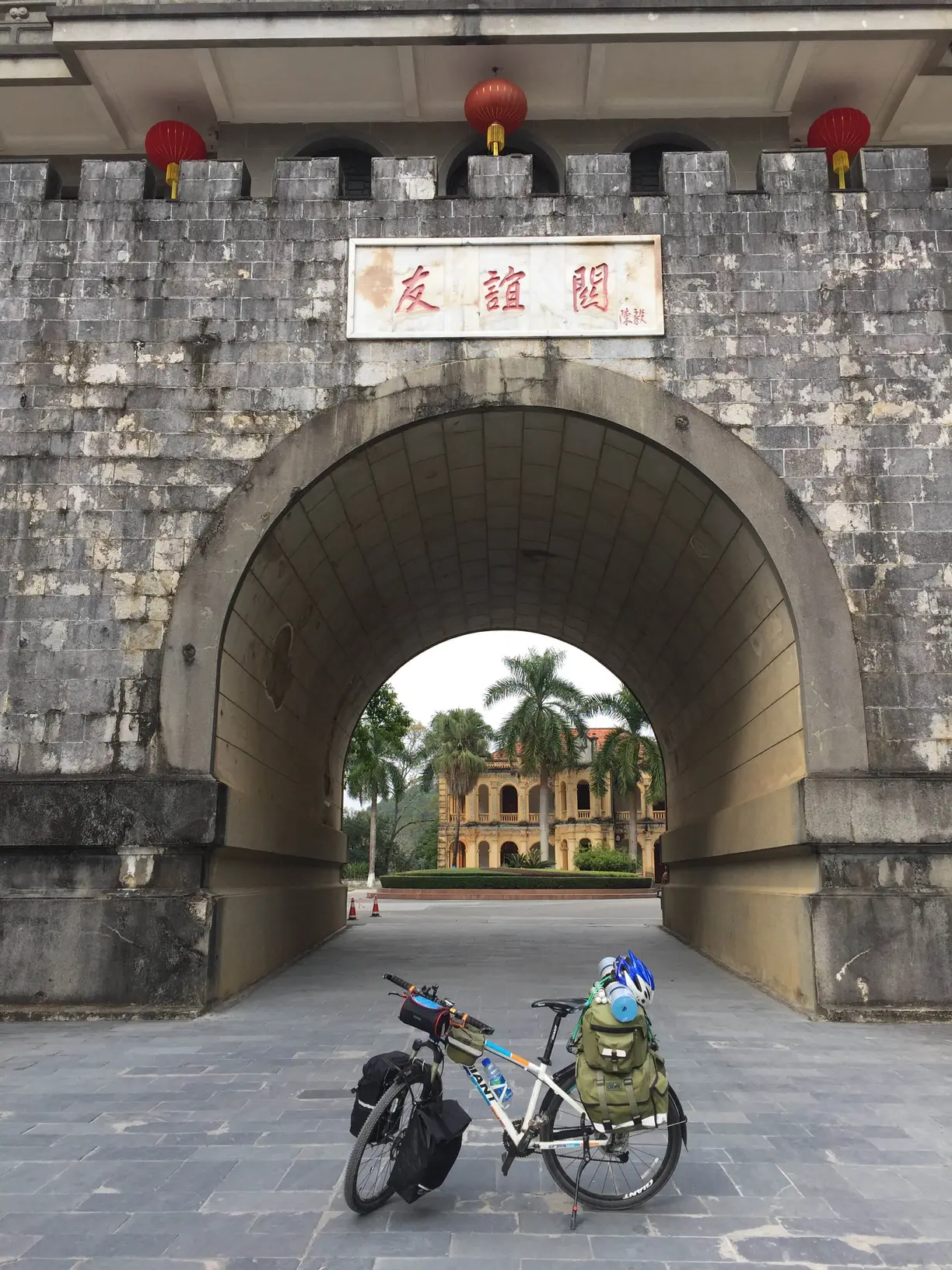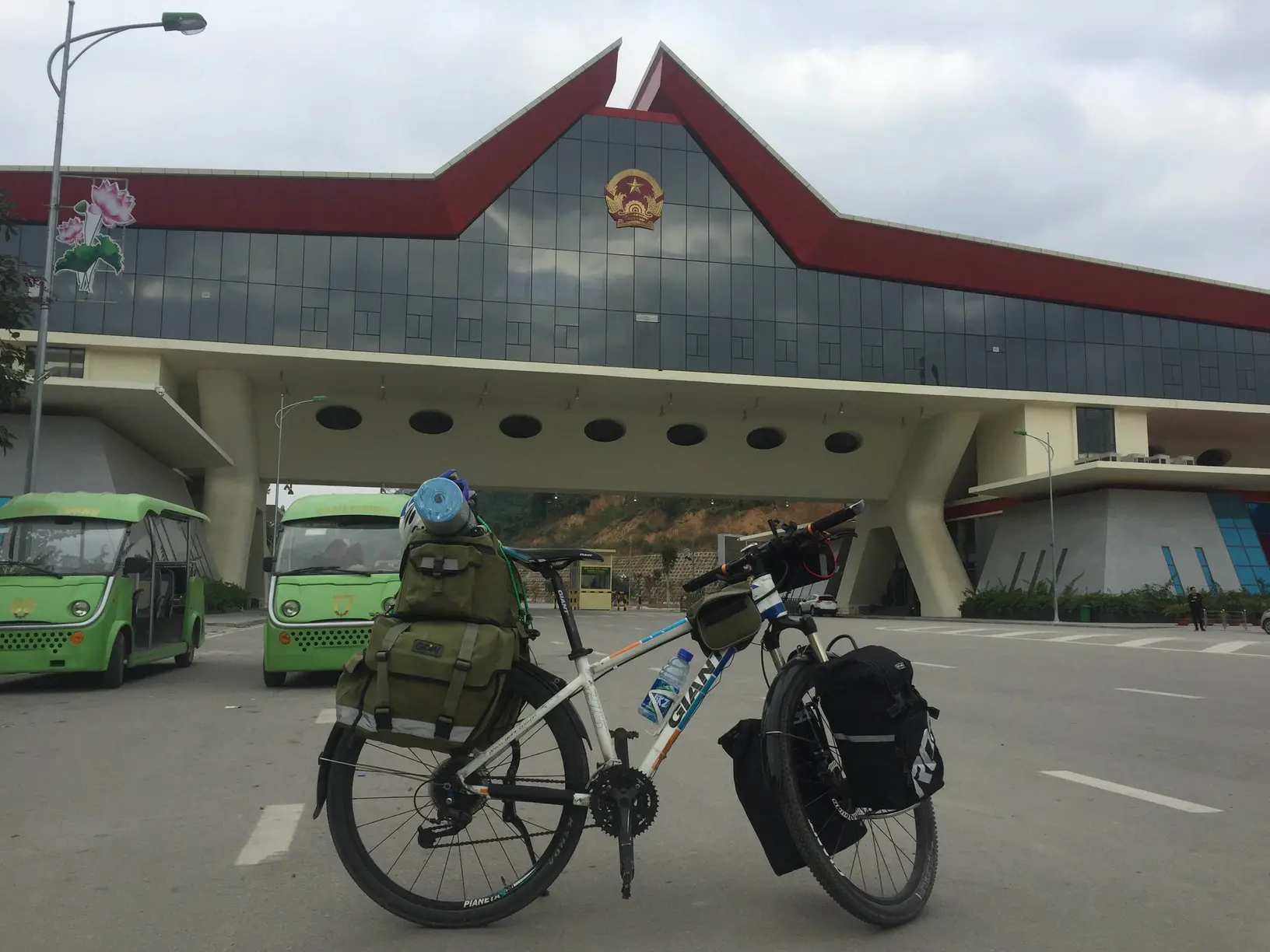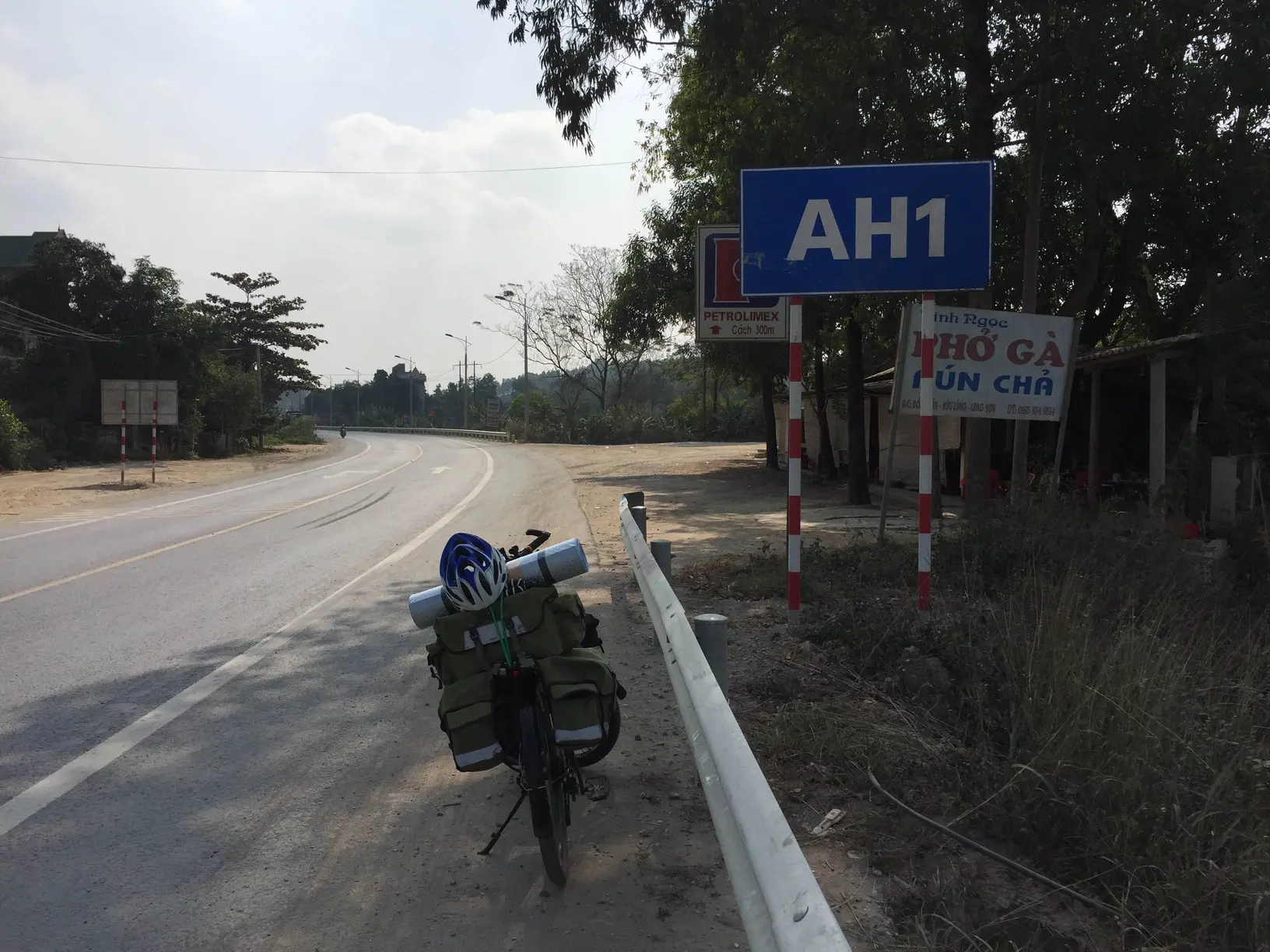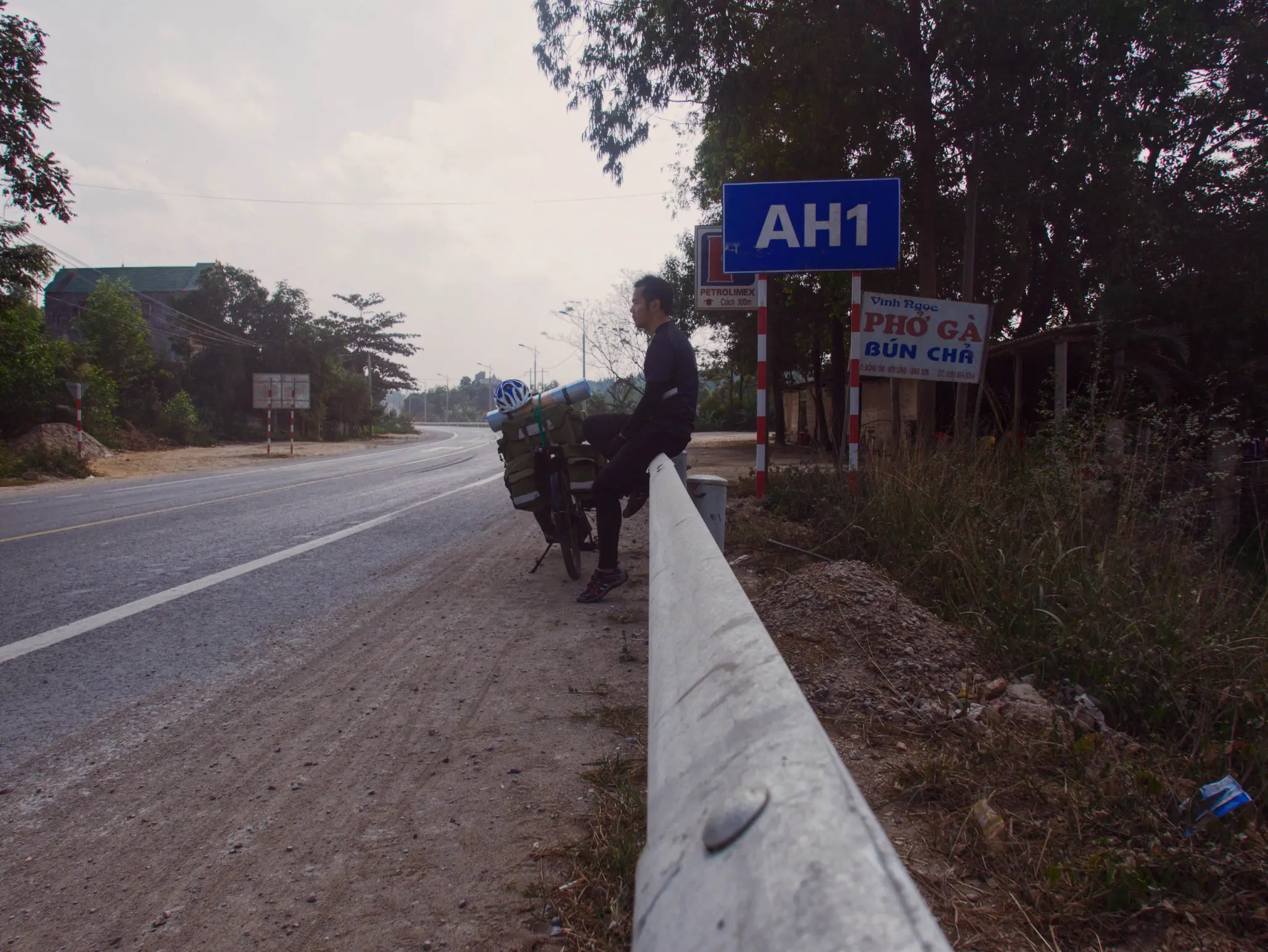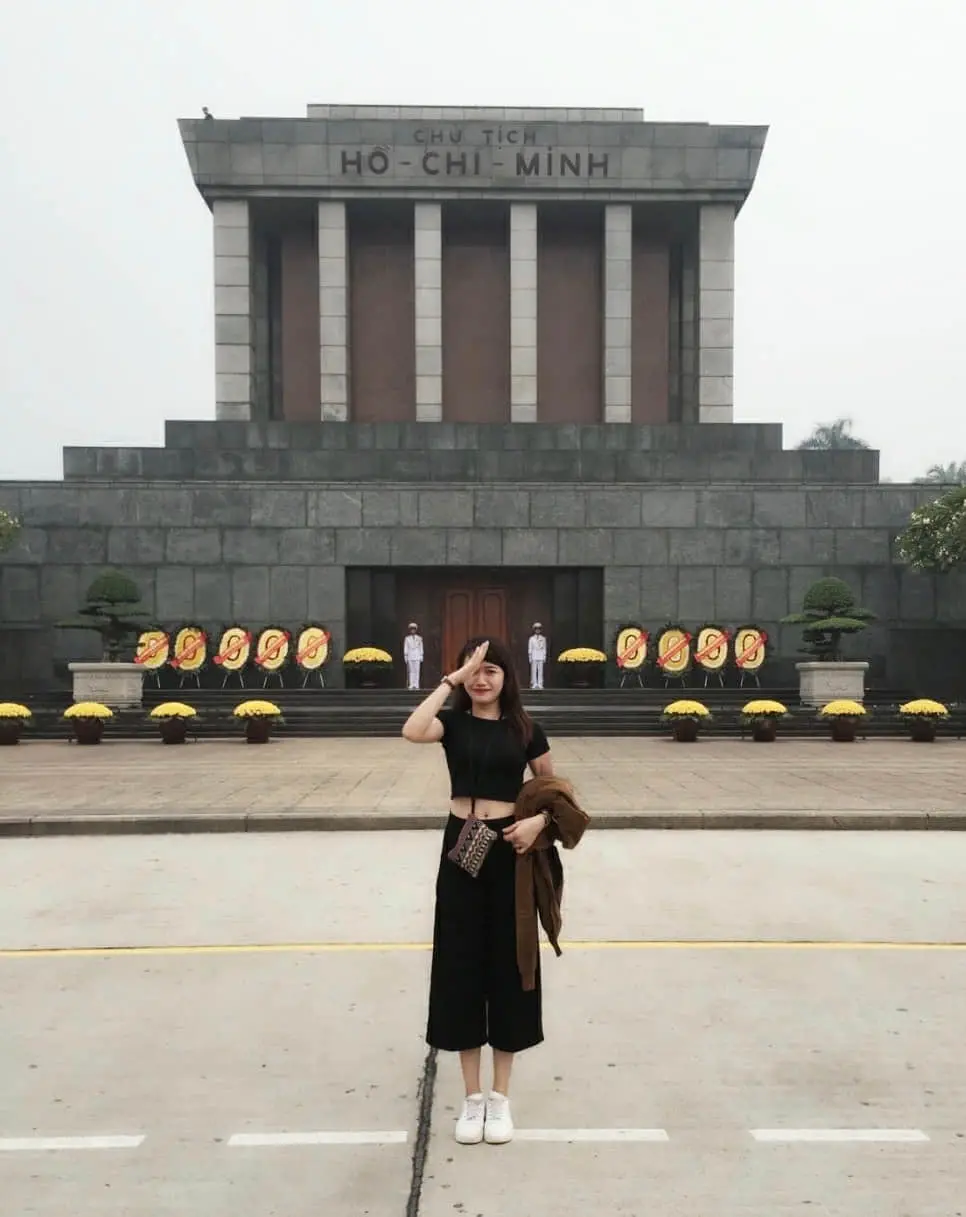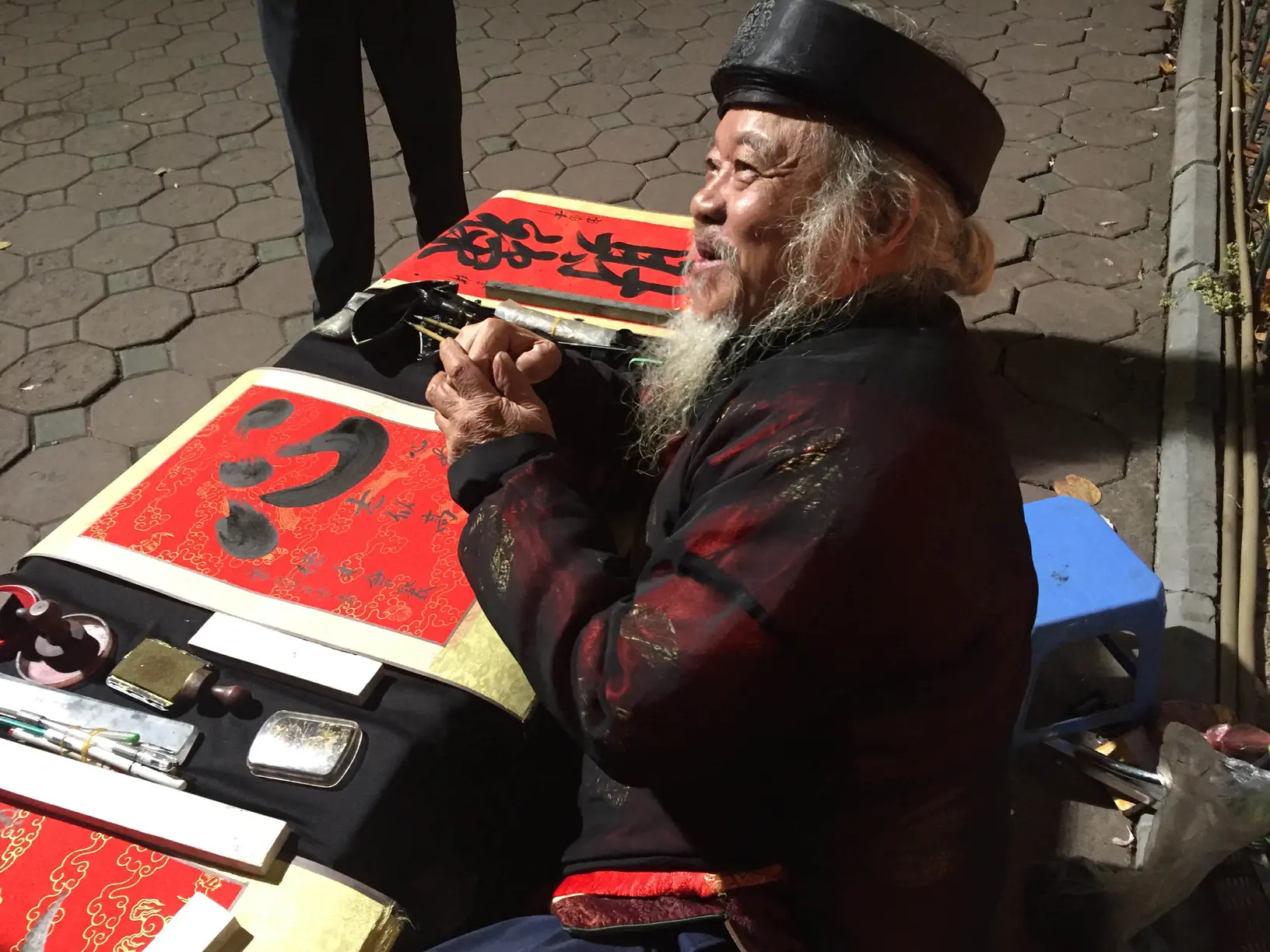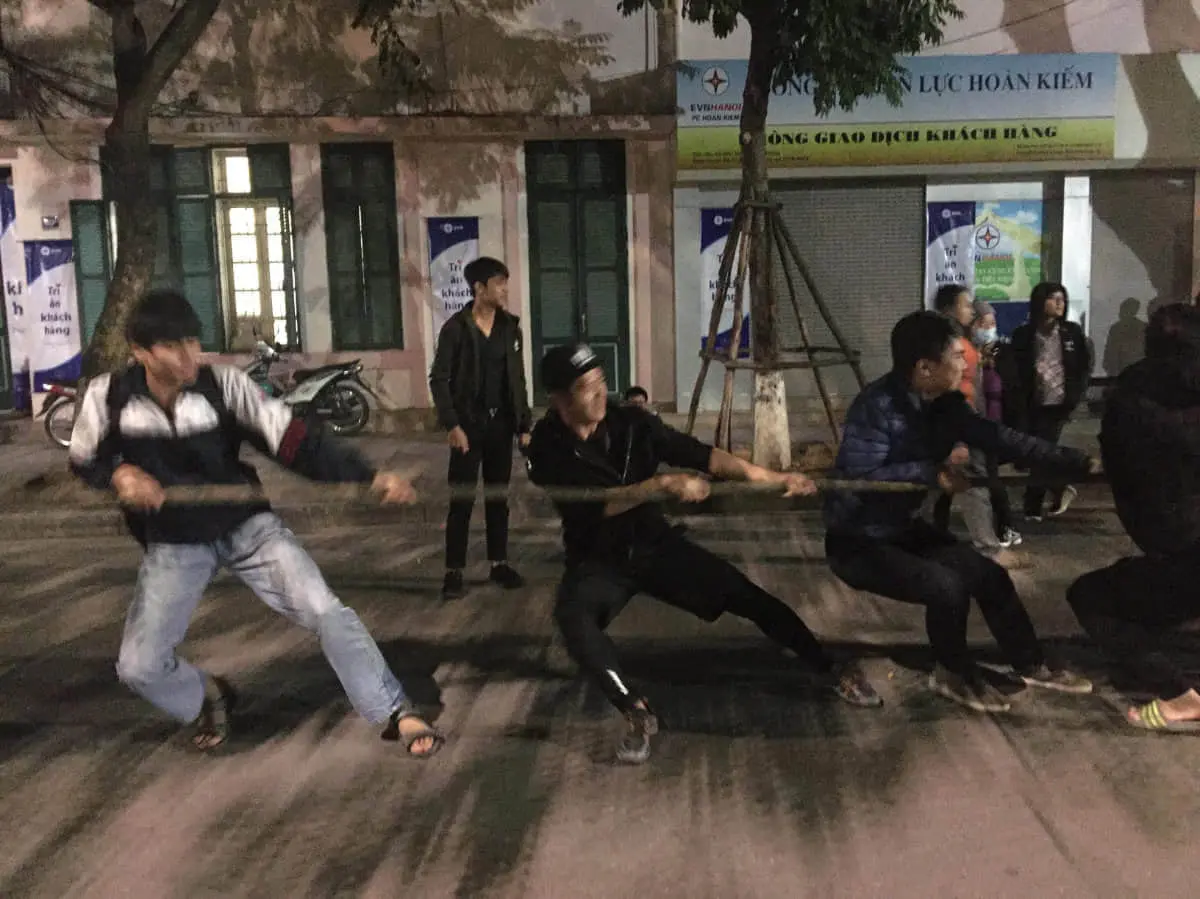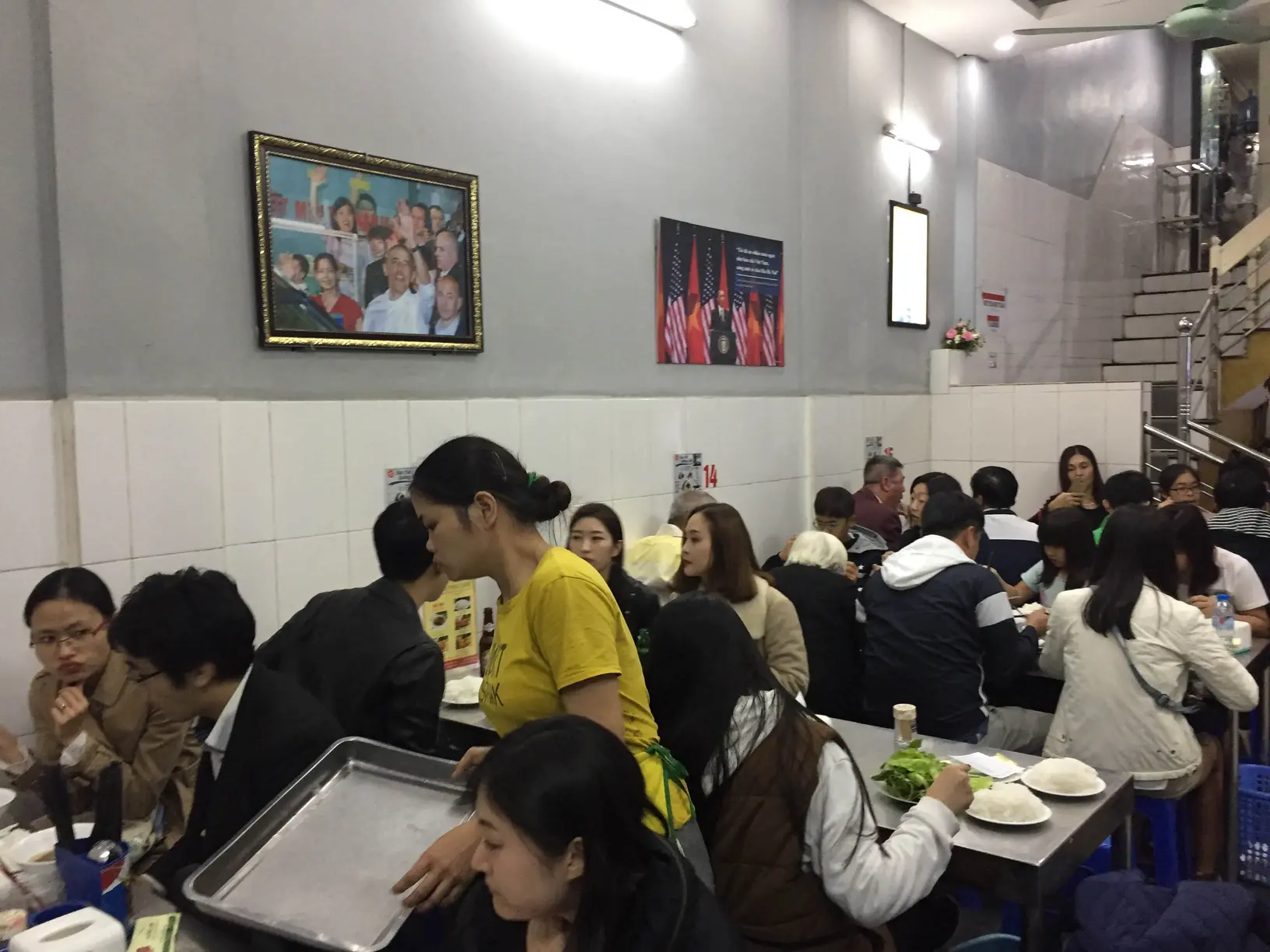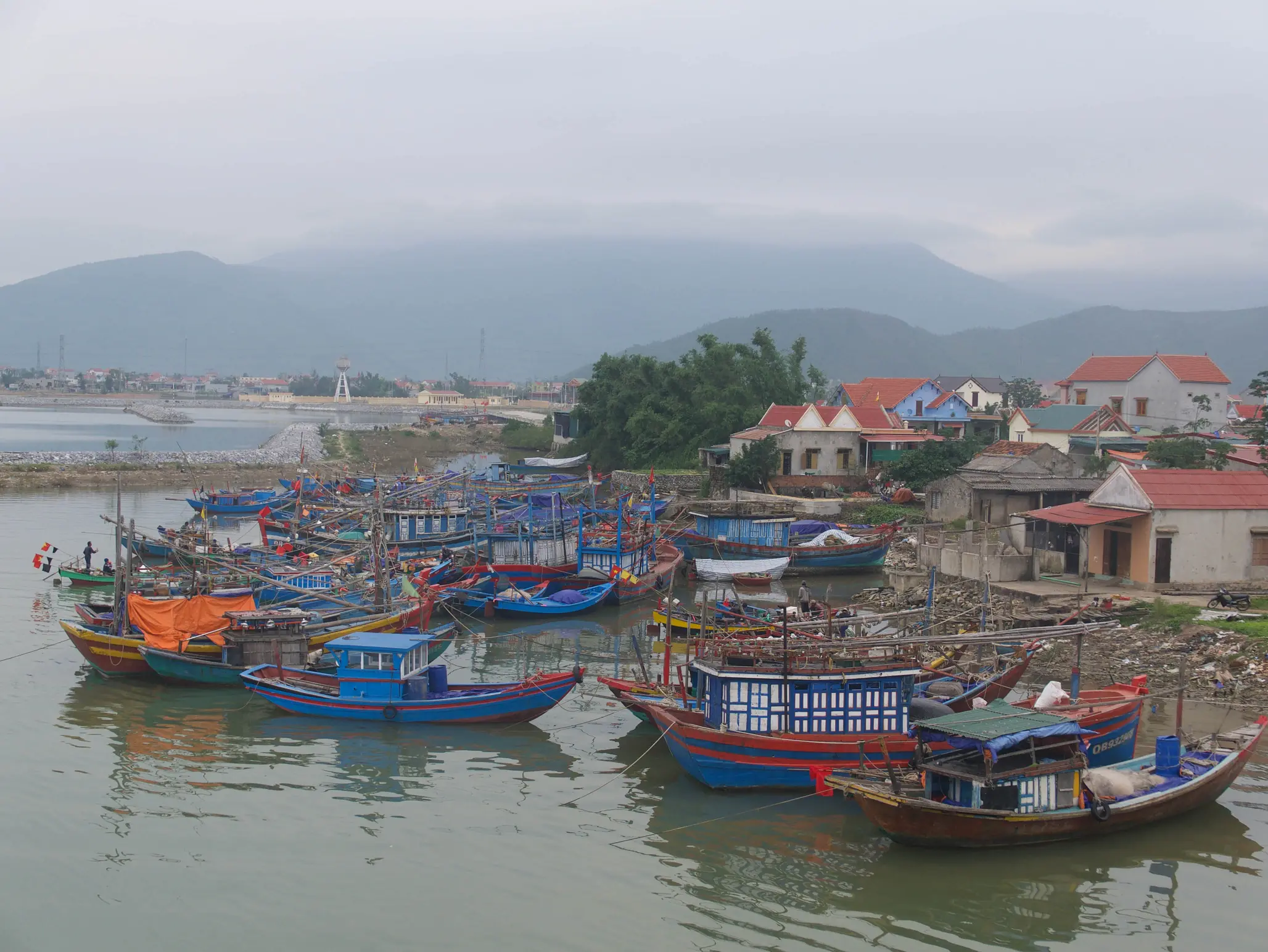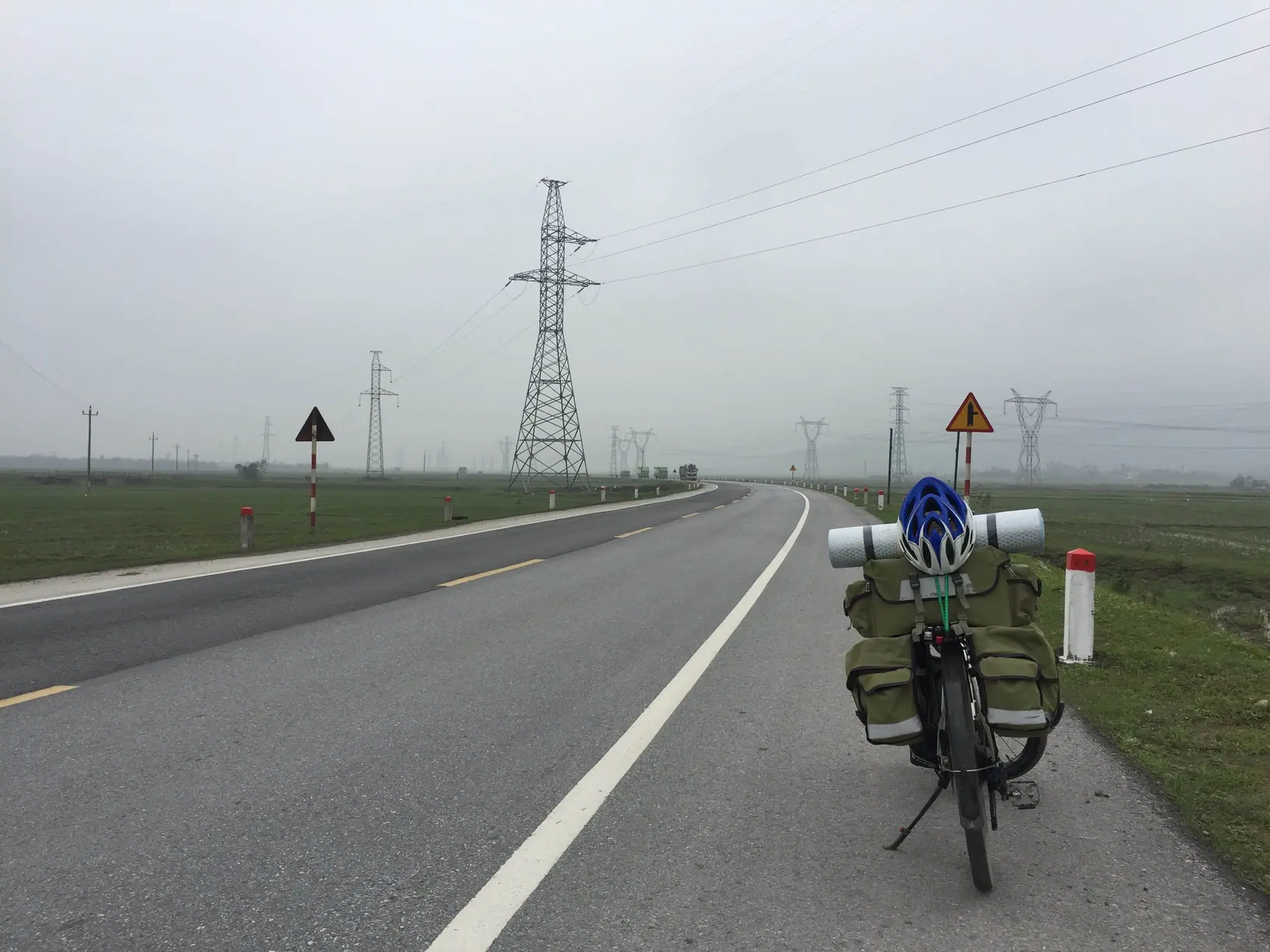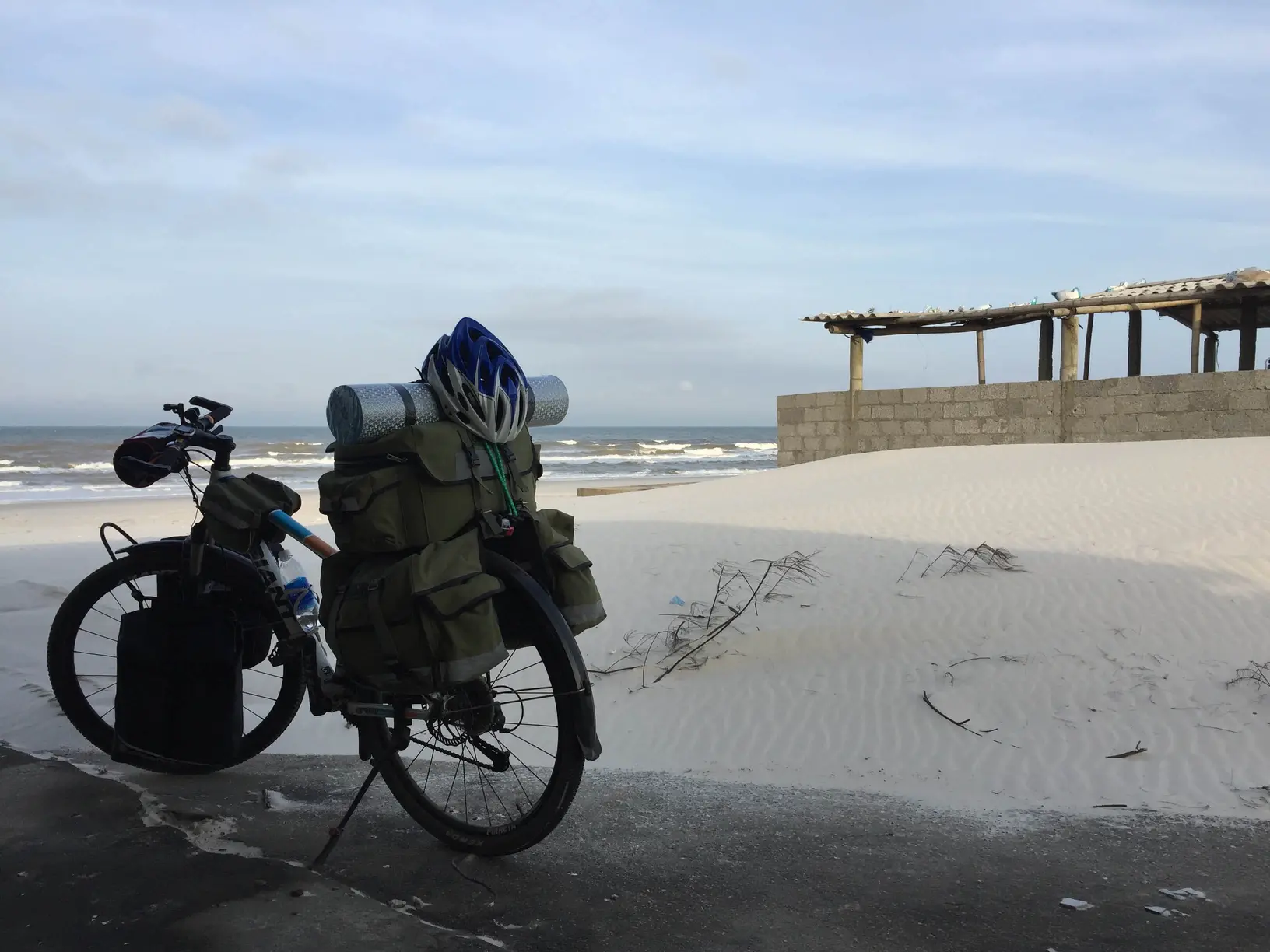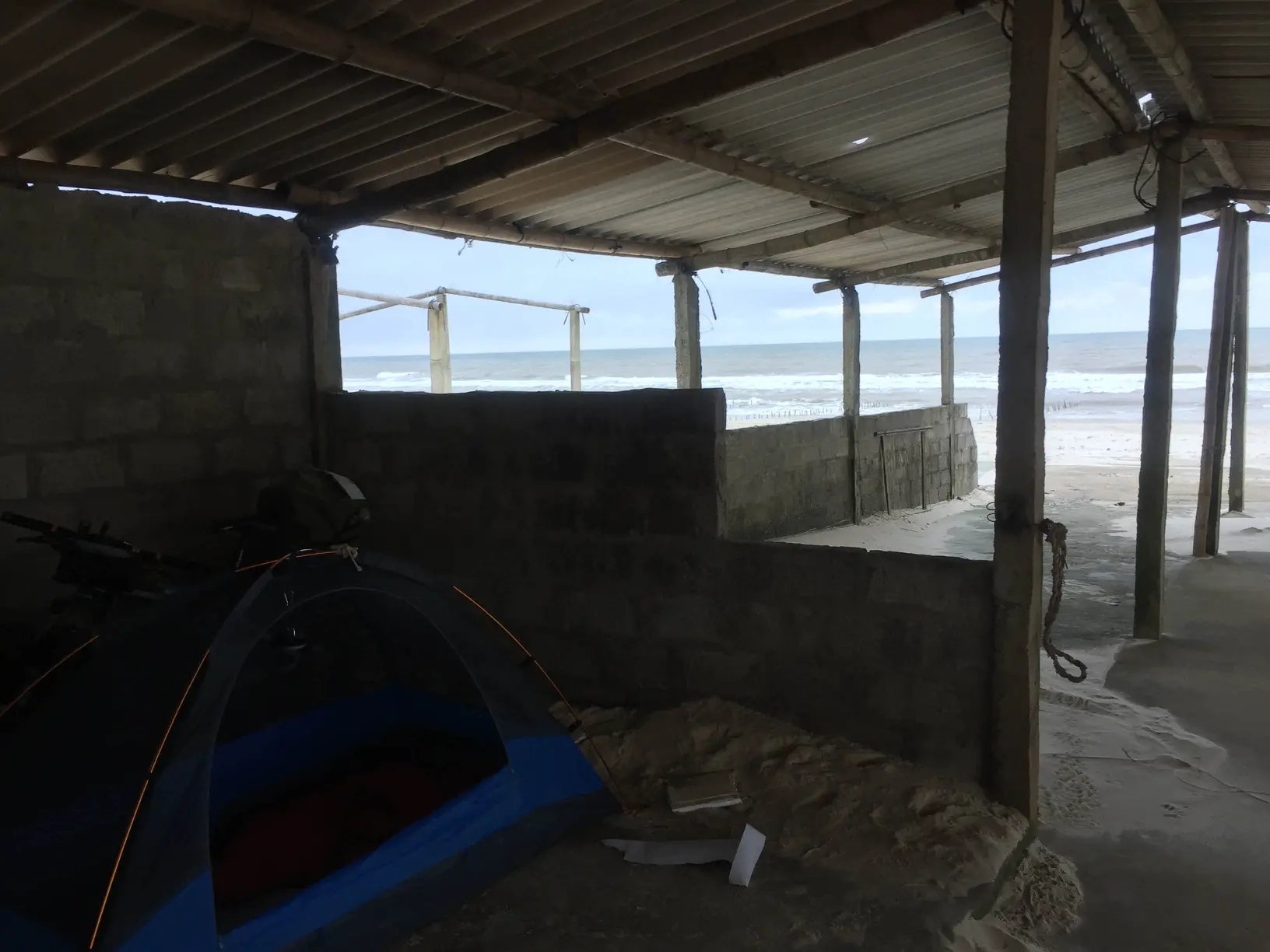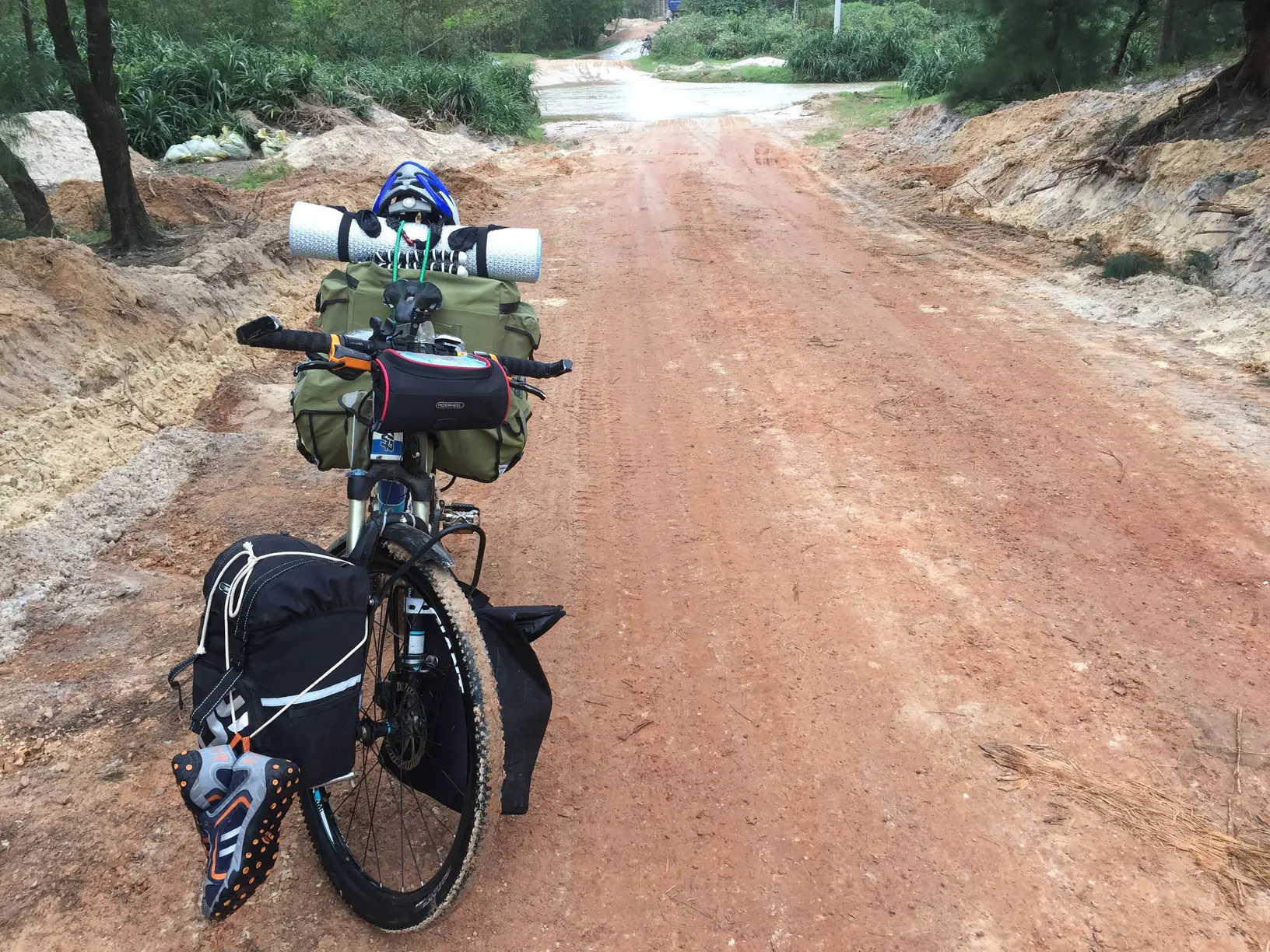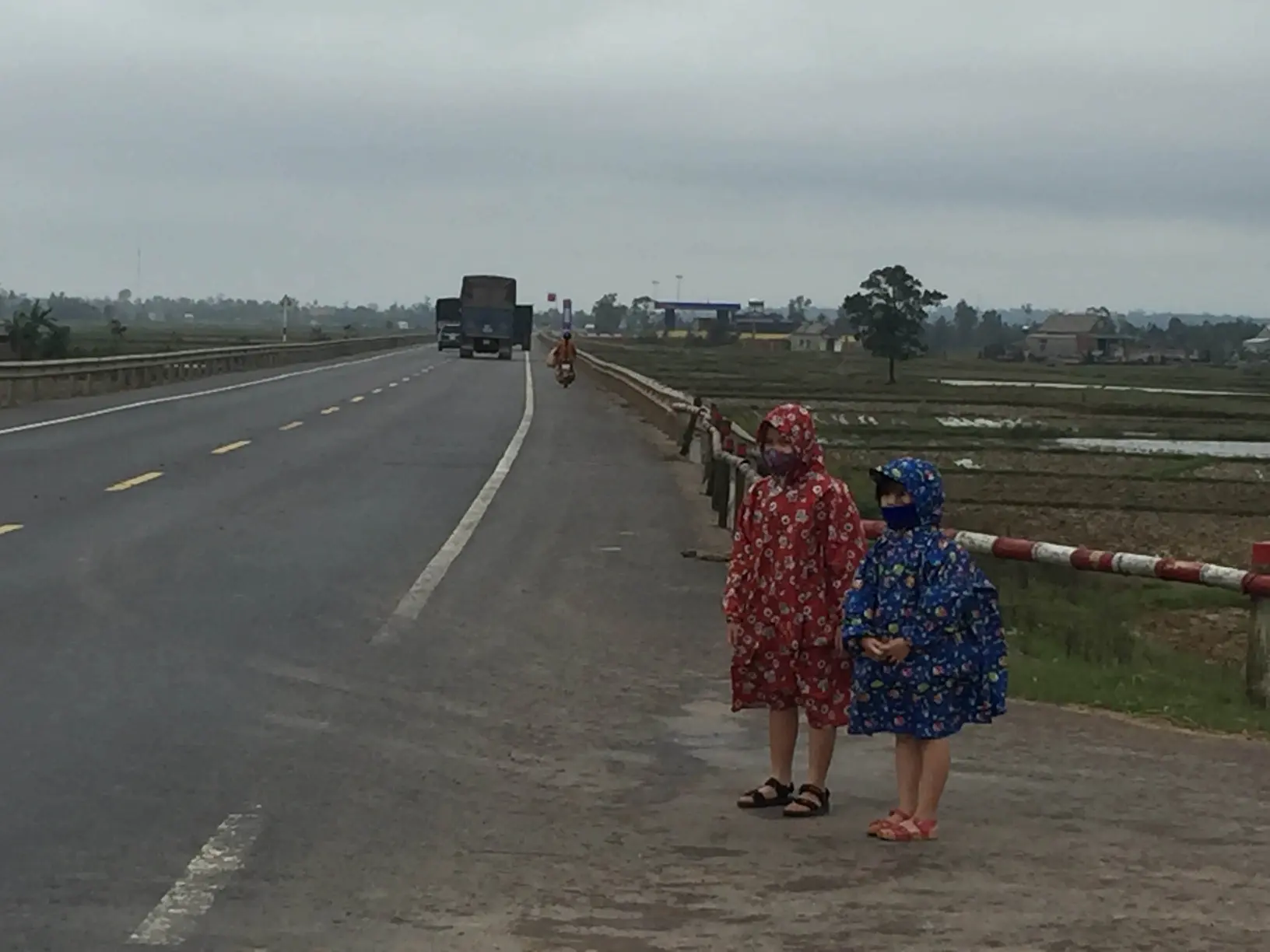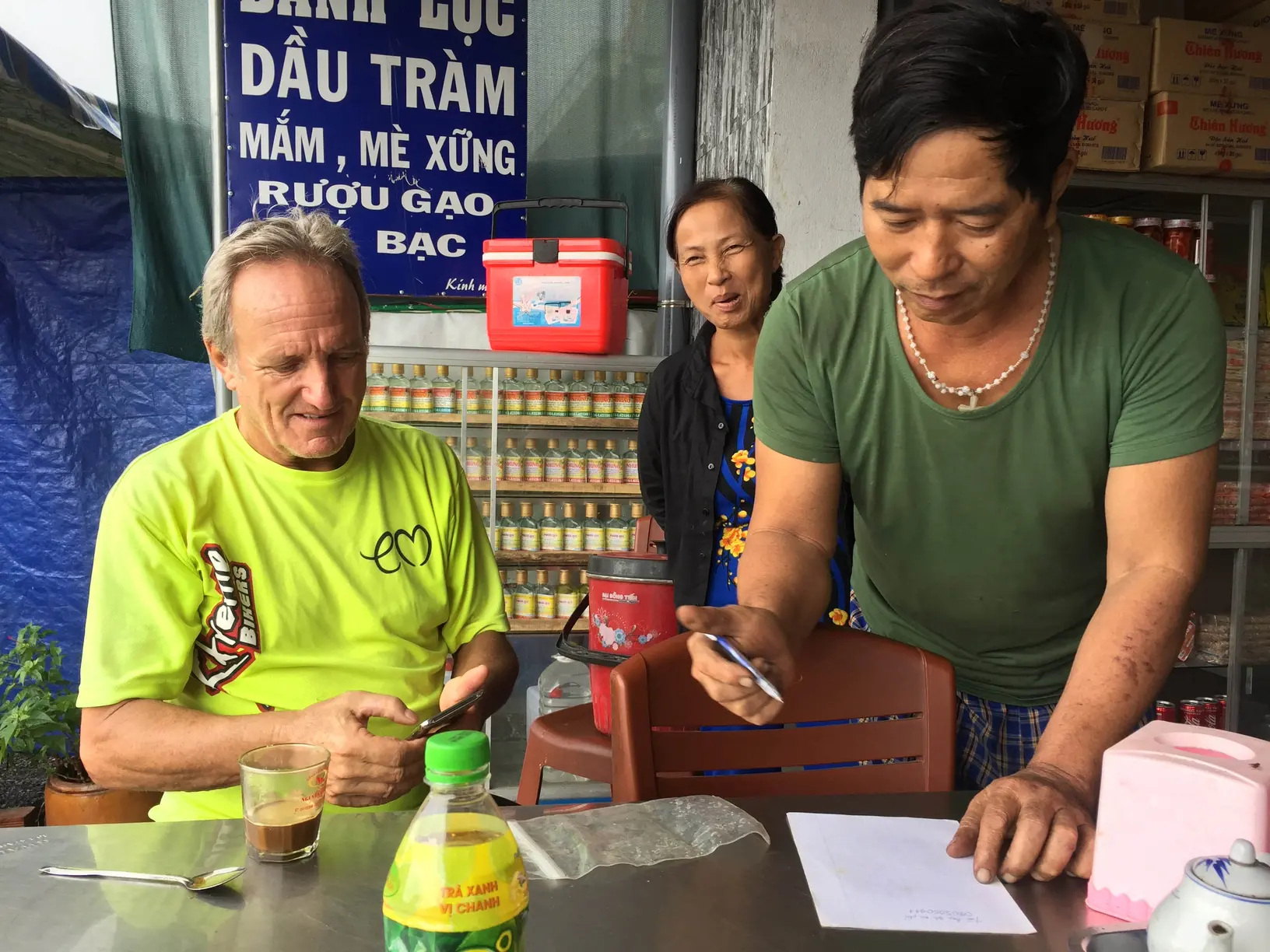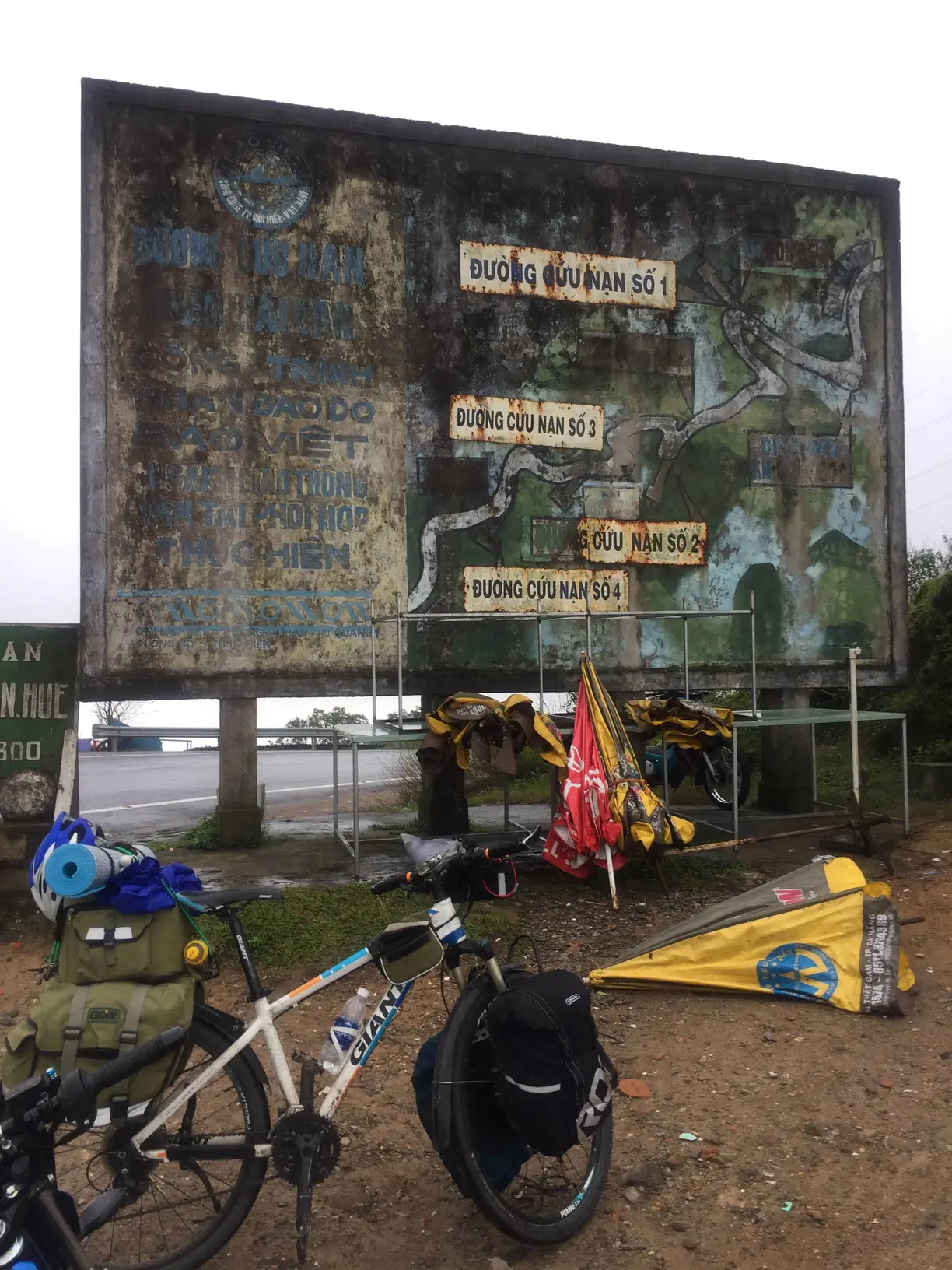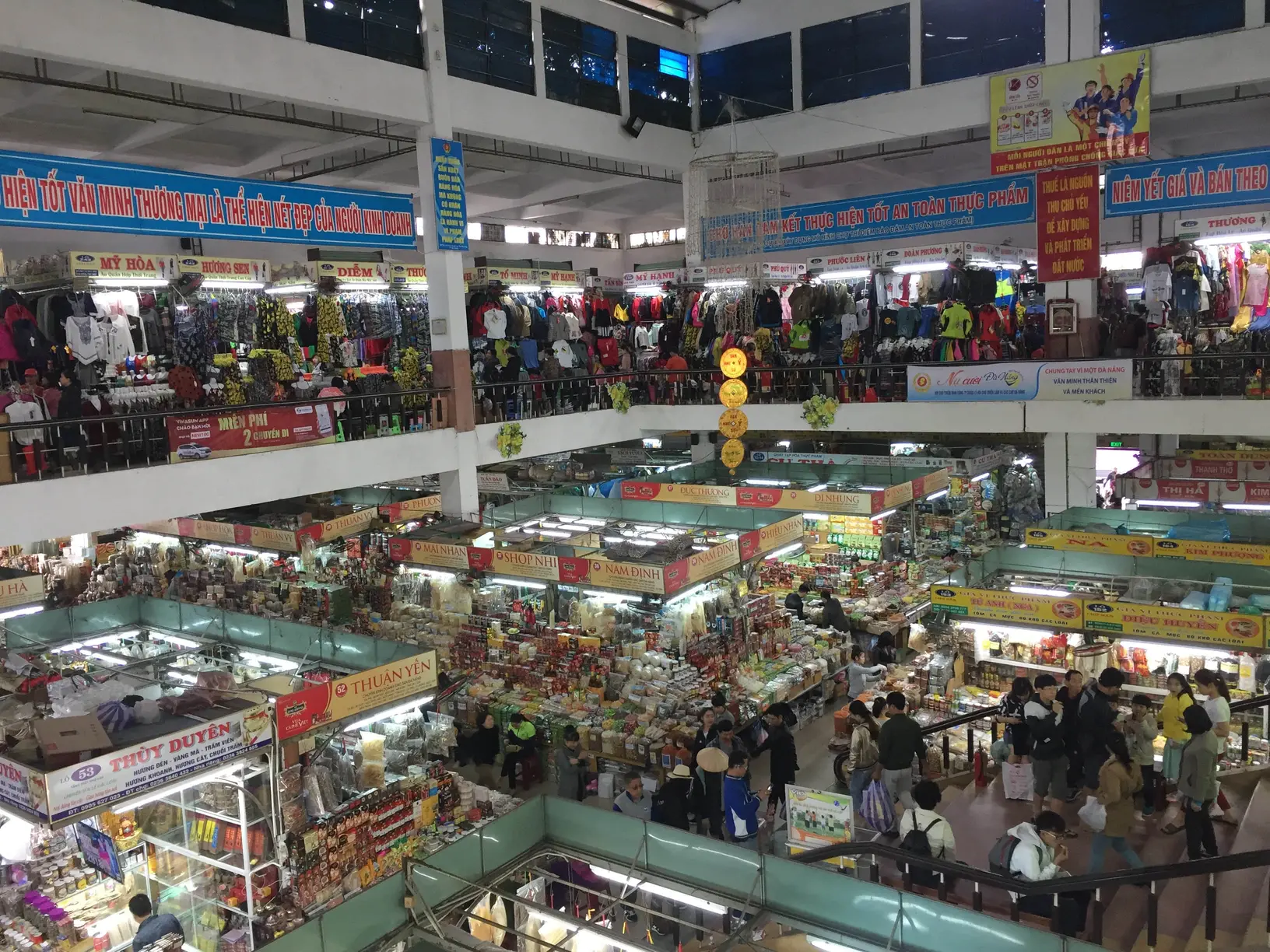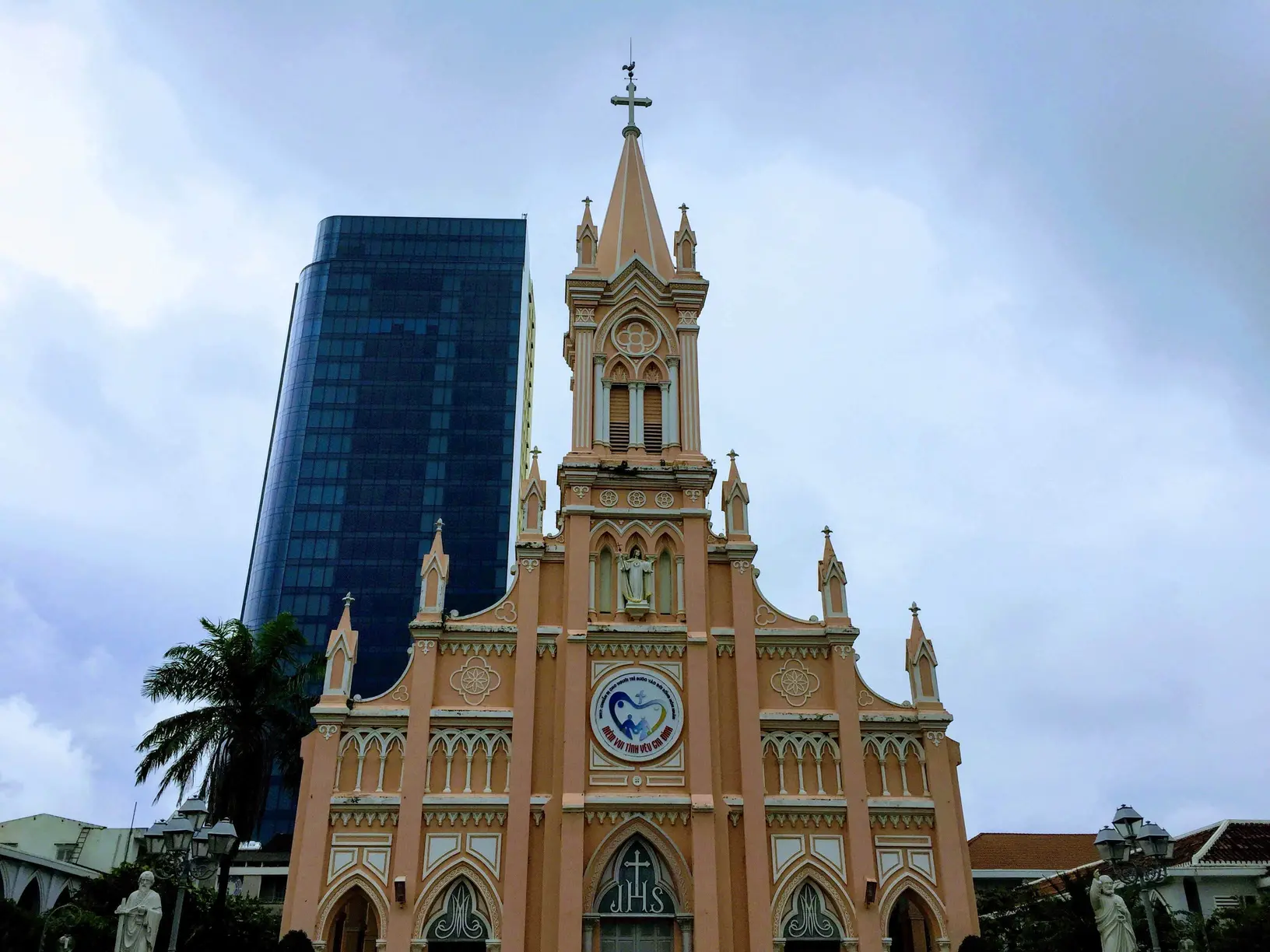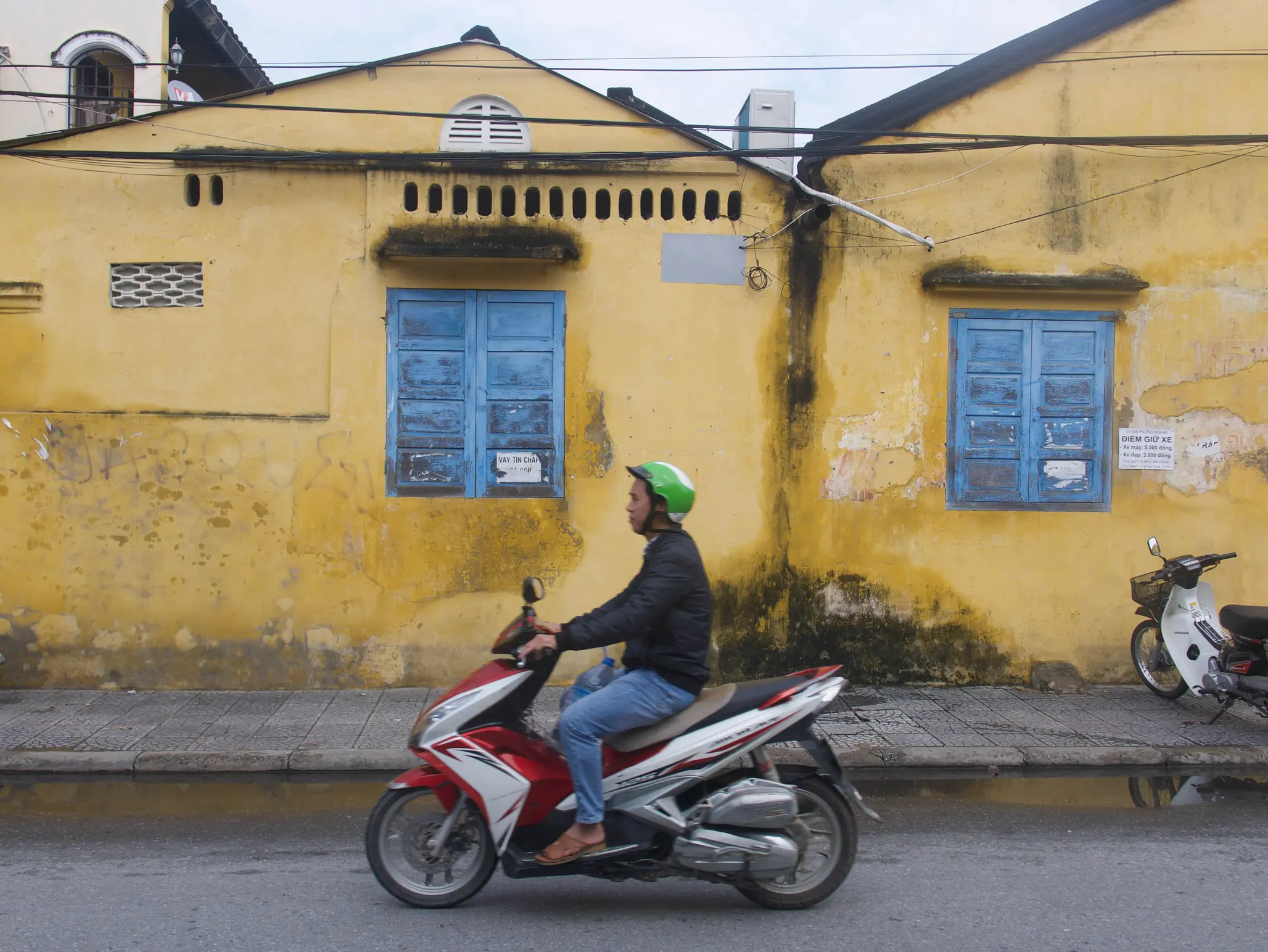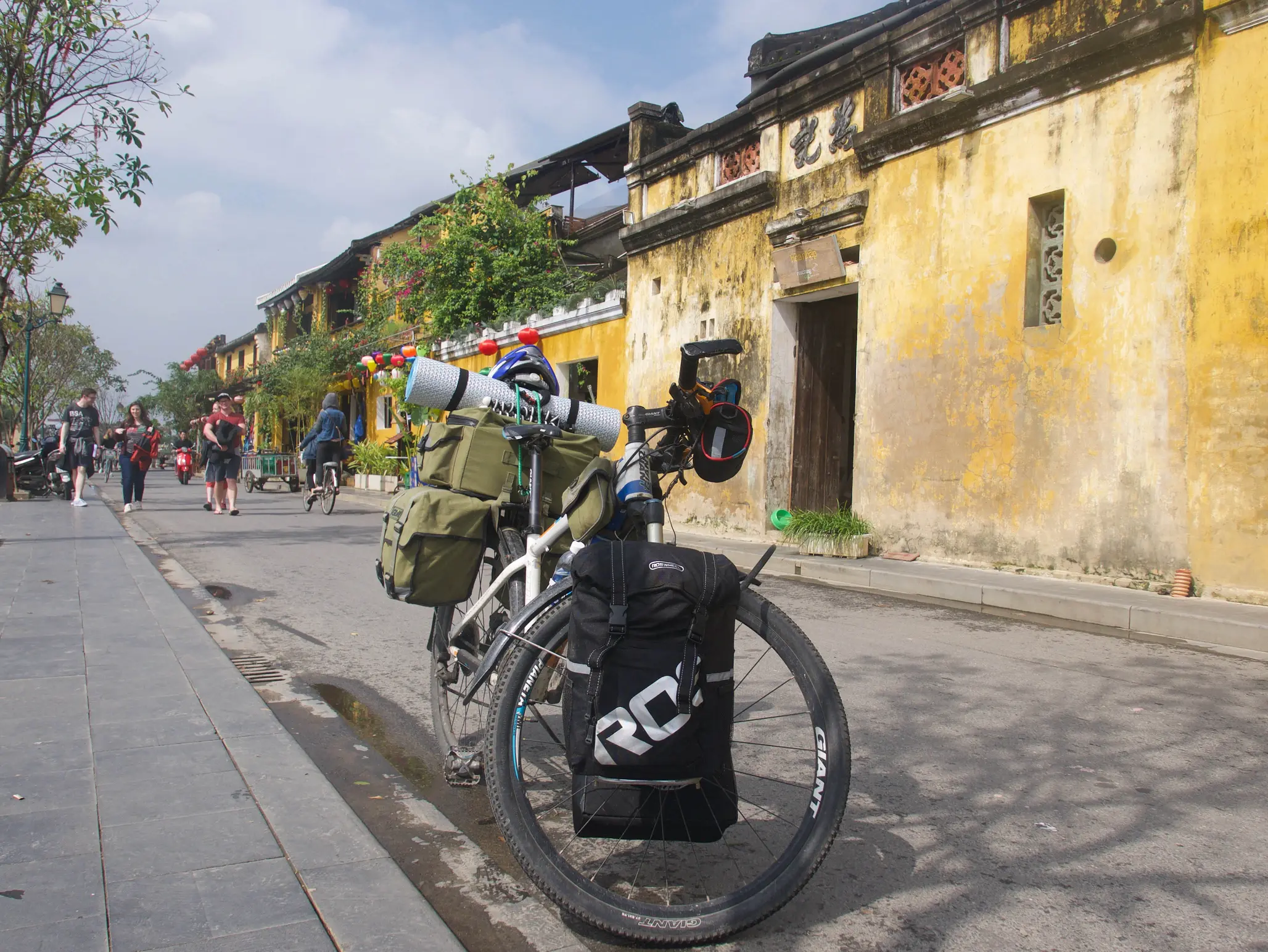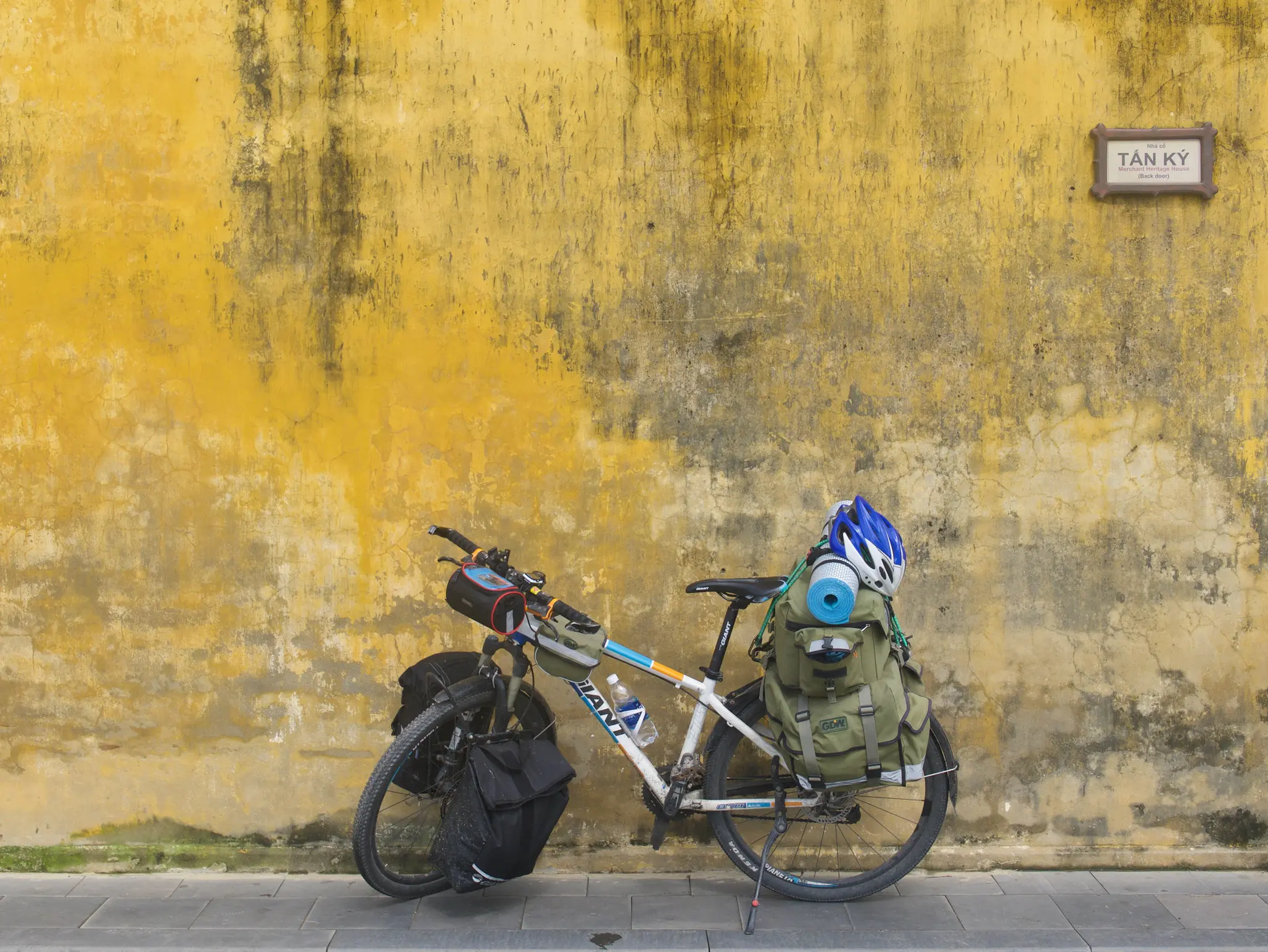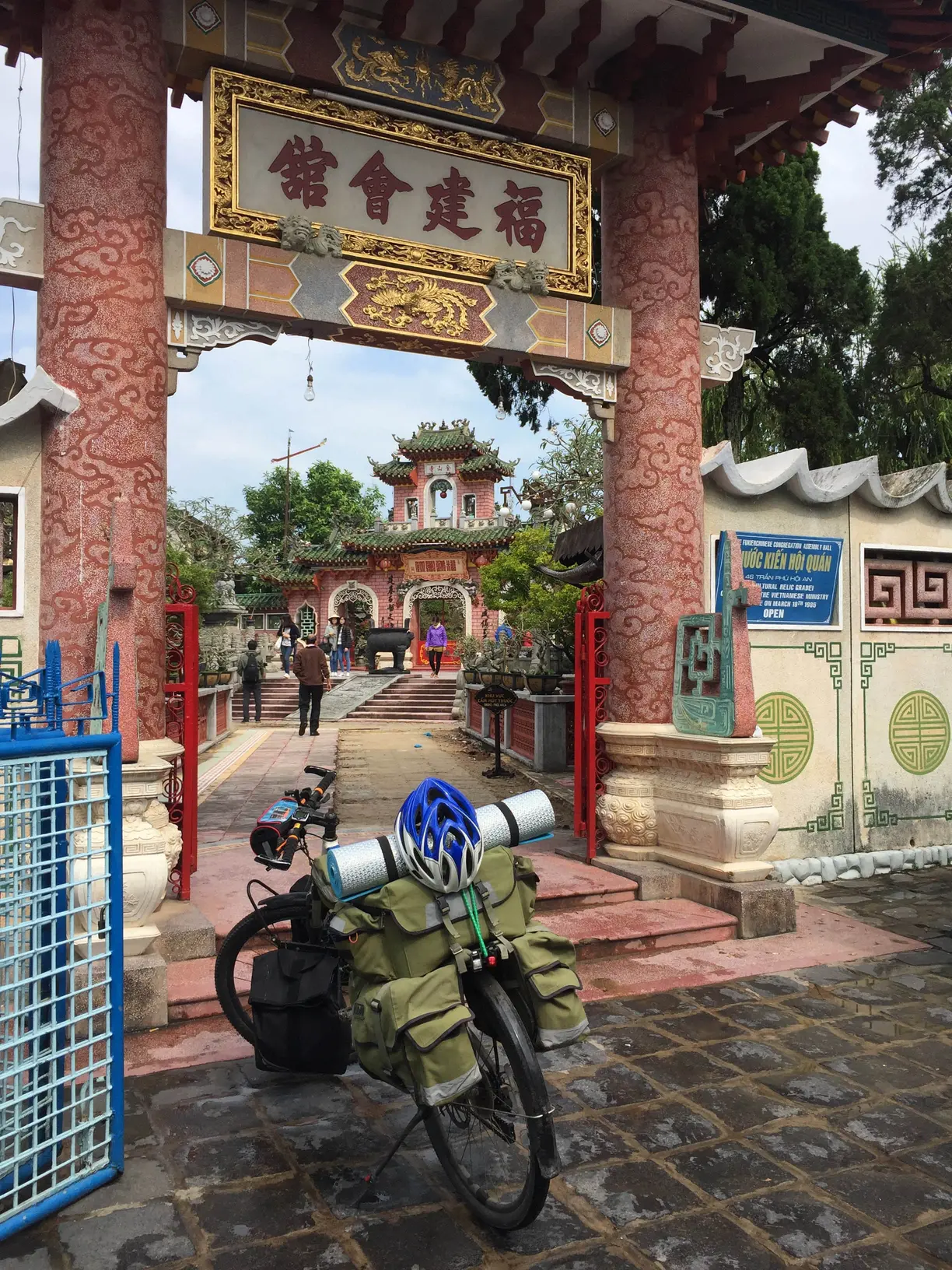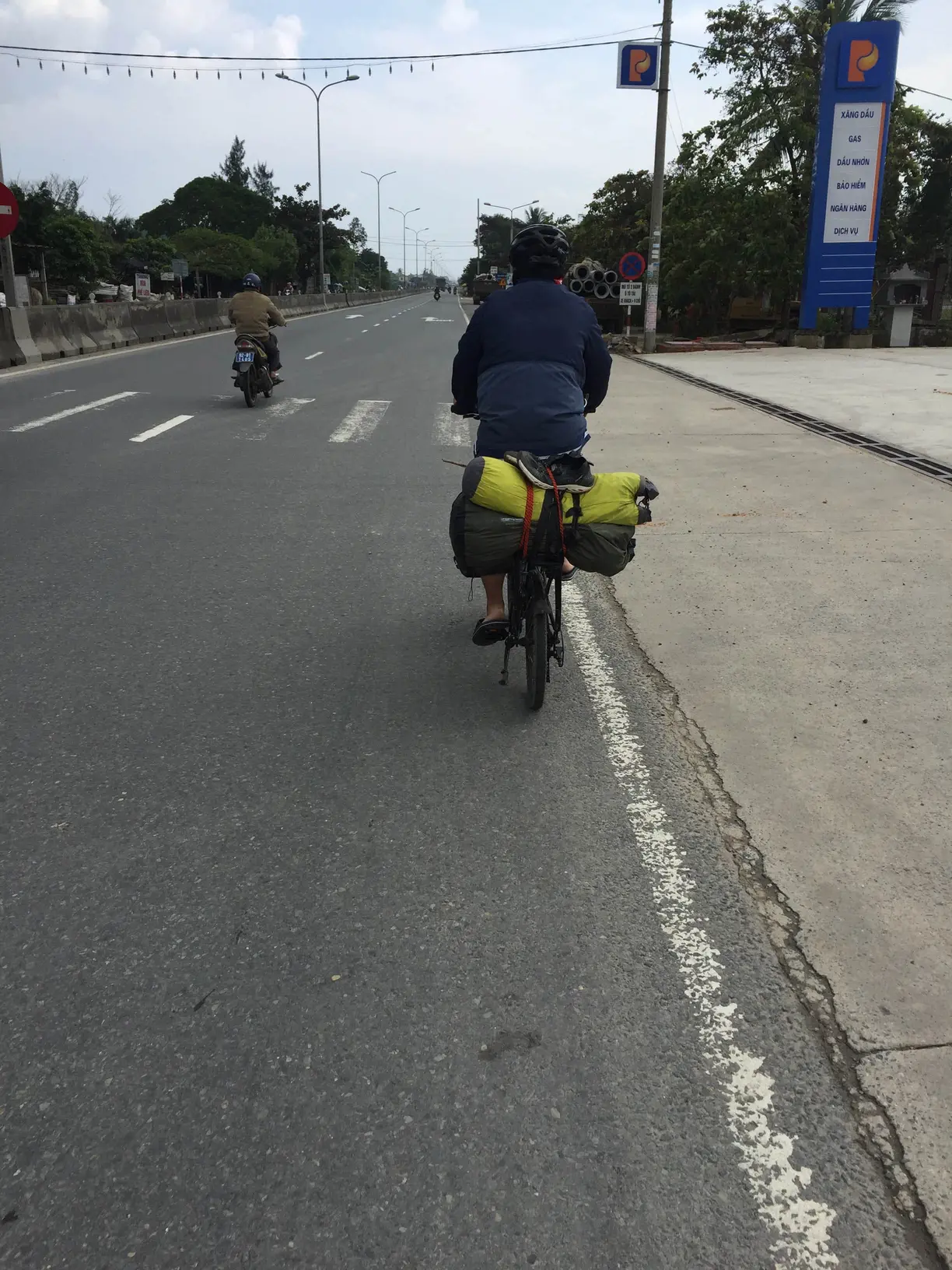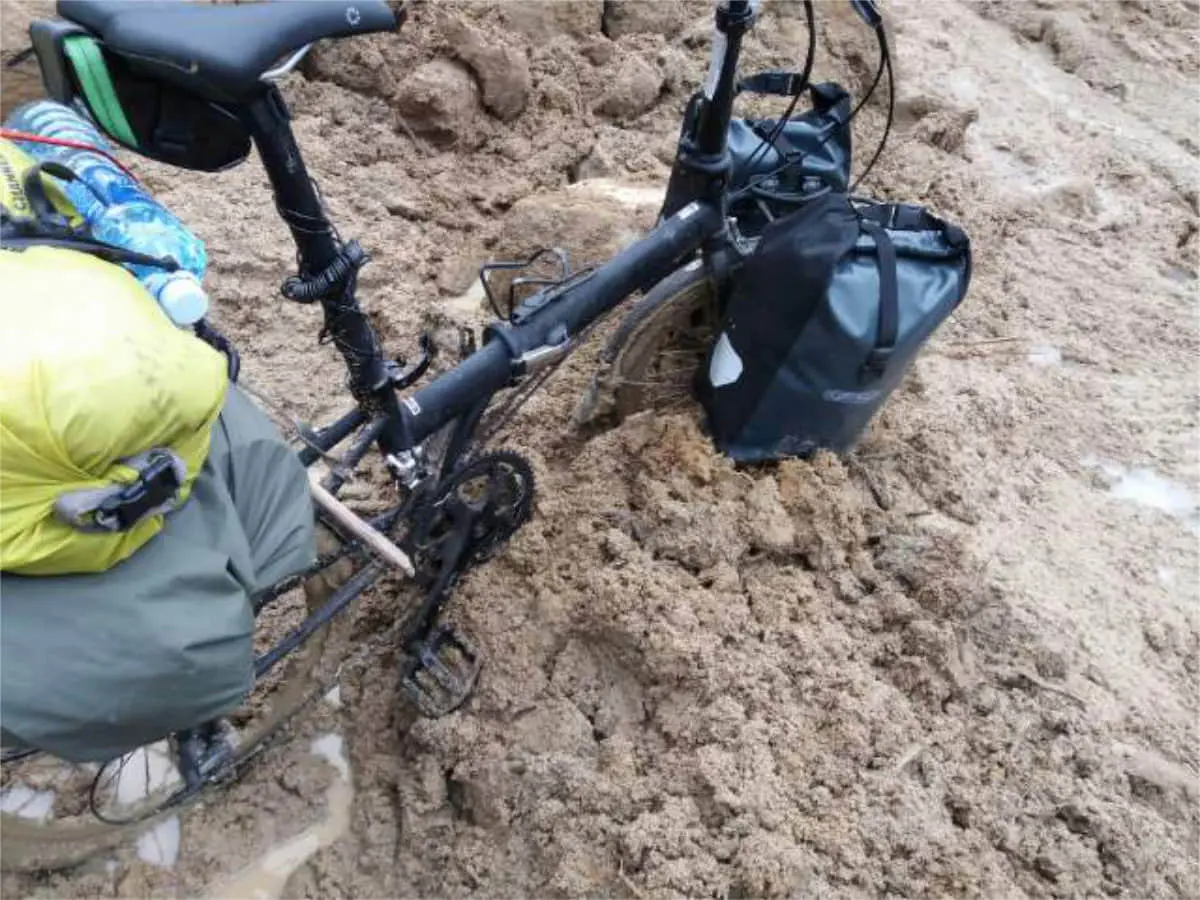1
After two or three days of cycling in Guangxi, I had adjusted to the road conditions. The scenery on the highway was much the same: houses, farmland, and wasteland. There were also pedestrians, cars, and big trucks.
When I arrived at the Friendship Pass, the sun was still scorching. The sweat dripped down my face and left different shades on my backpack, which had a Vietnamese visa, so I didn’t need to buy a ticket to enter the scenic area. The immigration checkpoint was inside the scenic area.
I took some photos and briefly visited the customs office, city walls, and French-style buildings. Then I took a break, changed some money, and bought a SIM card. After changing the SIM card, my phone automatically adjusted to the local time zone, which was an hour behind China.
I queued up, got stamped, and passed the immigration checkpoint. As I pushed my bicycle forward, a security guard asked me to take off my backpack for inspection. I followed his instructions and removed the straps, helmet, moisture pad, and tripod, placing them on the ground. Then I opened the buckle of my rear backpack and dragged it onto the conveyor belt of the inspection machine. I watched it slowly move forward.
“Do I have to go through security with those two front bags?” I pointed to the two bags.
“No need. Since you are riding a bicycle, you probably don’t have anything illegal. Go ahead.”
After leaving the Chinese customs building, I followed the signs and pushed my bicycle for a few hundred meters to the Vietnamese customs building. I queued up again, got stamped, and passed the immigration checkpoint without being stopped or checked.
Outside the building, I opened Google Maps and planned my journey to Lang Son, which was only about 20 kilometers away, so I thought it would be an easy ride. I saw a makeshift shop on the side of the road and walked up to buy a bottle of water. I couldn’t understand the price the shopkeeper quoted, so he took out a plate of Vietnamese dong, picked one himself, and gave me change.
Due to the altitude difference, the road from the Friendship Pass to Lang Son was mostly downhill. The road, signs, and small shops were no different from those in Guangxi, but the Latinized Vietnamese language, strange naming rules for license plates, and Western-style big trucks reminded me that I was in a foreign country.
I rode on the far right side of the road, braking frequently even though I was mostly going downhill. I couldn’t be too careless or go too fast because the road conditions were unfamiliar, and motorbikes often whizzed past me from behind, the left, or the right.
In the evening, I arrived in Lang Son. Most people tend to compare unfamiliar places with the scenery they are familiar with. Lang Son didn’t have tall buildings, and the road planning was mediocre, with infrastructure lagging behind. Many Chinese people who come here tend to make similar comments like, “Even the county town I live in is better than this place.”
I managed to find accommodation with the help of Google Translate and Google Maps.
2
AH1, the Asian Highway 1, is the longest highway in the Asian highway network, spanning 20,557 kilometers from Japan to Turkey, passing through various countries in Asia.
In Vietnam, AH1 is called QL1A, which runs through major coastal cities.
After waking up late and saying goodbye to the hotel owner without breakfast, I set off on my cycle towards Hanoi, which is 150-160 kilometers away. The first 50-60 kilometers were downhill, while the rest of the way was more undulating.
The weather was perfect, and the cloudy sky was suitable for riding.
After crossing the Long River, the city gradually came into view.
Following the directions on Google Maps, I turned right from QL1A onto a two-lane road. On this small road, motorcycles, pedestrians, and cars shared the narrow space, with drivers frequently cutting each other off, running red lights, and driving on the wrong side of the road. Accompanied by the constant honking of car horns and the roar of motorcycle engines, this scene of my familiar homeland helped dispel most of my feelings of unfamiliarity.
After crossing Long Bien Bridge, I finally entered Hanoi’s urban area. It is the city’s first steel bridge, built during the French colonial period from 1899 to 1902, designed by Gustave Eiffel, who is better known for his work on the Eiffel Tower in France.
During the Vietnam War, the bridge was one of the primary targets of the US bombings that destroyed parts of Hanoi. Despite the repeated attacks, the Vietnamese always managed to build temporary bridges promptly, and Chinese troops from North Vietnam also participated in the repair work.
At night, the bridge is illuminated with colorful lights, but the roads underneath can be confusing for newcomers. I had to ride against the flow of traffic for a short distance before reaching the bridge, joining other motorcycles and pedestrians along the way. While the colorful lights were beautiful, I had to keep my focus on the road, ready to brake at any moment, afraid that I might hit a pedestrian. After crossing the bridge, I felt relieved and didn’t have much of an impression, except for the narrow and bumpy road full of rocks, hoping that I wouldn’t get a flat tire.
3
If you look up in the sky, you might spot a person carrying a backpack as tall as themselves, dressed in T-shirt, shorts and flip-flops, ignoring the motorbikes rushing towards them from all directions, and moving forward at their own pace. Just like a rock standing in the water, the streams of motorbikes would instinctively find their way around them, passing by closely on all sides and leaving behind a trail of exhaust fumes.
In Vietnam, the motorbike is the absolute star, and most locals are skilled drivers.
The influence of China and France can be seen everywhere in this city, with temples next to churches, and coffee shops next to tea houses. Large Chinese characters are ubiquitous, while gothic spires pierce the sky.
On the street of 36 craft guilds, people sit on low plastic stools, ordering drinks and observing passers-by, guessing their age, nationality, and whether their companions are locals or foreigners.
By the shore of Hoan Kiem Lake, a crowd gathers for morning exercises, practicing swordplay, Tai Chi, and playing chess together.
My first impression of churches was pointed roofs, bell towers, and stained glass. To me, St. Joseph’s Cathedral in Hanoi was no different from other churches. Inside the church, I met two Chinese friends who had traveled from Nanning on the T8701/MR2, and through them, I met three other girls, one of whom was a lively Vietnamese girl named Nguyen Xuan.
Every Friday afternoon at 5 pm until Sunday night at 10 pm, the roads near Hoan Kiem Lake are closed to motorized vehicles, turning the area into a playground. Locals gather to play games like Jianzi, jump rope, badminton, sing, dance, tug of war, and play stone games. Visitors can easily join in the fun as well. I asked Xuan to let me join the tug of war team, and the leader quickly agreed. I took a deep breath and stepped up, but I lost.
Not giving up, I tried again, and I lost again. Ha ha ha, it was really fun. “Xuan, what’s over there? Let’s go take a look.”
During my stay in Hanoi, I thought of Ebenezer Howard and Jane Jacobs, two pioneers in urban planning who became bitter enemies.
To Howard, the city was a theater for social activities. City builders and planners provided people with stages to perform on, and city life was diverse and multifaceted. Differences and struggles created opportunities, and cities created drama that rural life lacked.
Jacobs believed that the biggest difference between cities, towns, and rural areas was the presence of strangers in the city. Underneath the dirty and chaotic exterior of the old city, many places developed amazing harmony over time, bringing safety, inclusiveness, order, and freedom, like a ballet performance. Dancers each performed their own movements, ultimately creating a wonderful whole that cooperated with each other.
Hanoi provides such a stage, with a bustling city, closed roads, and a large number of people, locals, tourists, onlookers, vendors, and merchants gathered together. Various performances take turns, one after another, creating a “city theater and street ballet.” You can be an observer and recorder or actively participate without hindrance. This is the charm of the city.
4
After indulging in various roadside stalls and spicy and meaty dishes without care in Hanoi, the consequences finally appeared: weakness, fever, and diarrhea one by one. I relied on ibuprofen to get rid of the fever, but stomach pills were powerless against the remaining illnesses. With the help of Nguyen Xuan, I bought two types of medicine, and after taking them, I quickly felt better. I don’t know if the medicine was really effective or if it was just a placebo effect.
5
If you pitch a tent in mainland China, you may encounter the following situations: being refused and waved away without a word; being accepted and even offered a room to stay in; being accepted and then rejected by someone else…
In Vietnam, there may be another possibility: being driven away by the police.
I saw an excellent camping spot on Google Maps: near the beach and at a suitable distance. I arrived at the spot a little after 4 pm, while it was still light outside. Looking around, I found a tea house and decided to set up my tent there since the weather forecast said it might rain and this place had just the right amount of shade.
I showed the travel instructions translated by Autumn Xuan and tried to communicate with the host, a mother and her young child, using gestures and a mix of languages. Finally, they agreed to let me pitch my tent there.
As I was unpacking my bags and getting ready, two unexpected guests arrived and demanded to see my passport with blank expressions. At first, I thought it was the host’s husband returning and asking to see my ID, as it was usually the case when I camped in China.
Later, I learned that I had misunderstood. Onlookers told me that they were the police.
Two policemen spoke to the homeowner, and the young homeowner took my phone and translated for me: camping is not allowed here, it’s not safe, there is a roadside inn outside.
I could see that the situation was not favorable, so I tried my best to explain my intentions, hoping to get permission. After a bit of argument, it was still unsuccessful. The police officer didn’t even want to speak directly to me, but turned his head to talk to the young homeowner, who then used his phone to translate for me.
At this point, I had to give up. I packed my luggage in disappointment, put the sleeping bag and tent back in the camel bag, re-tied the moisture-proof pad, helmet, and tripod, and the diners watching in silence. The two policemen checked my passport and whispered to each other, flipping through it from the first page to the last and then back to the front.
The young homeowner came to my side and used simple English words to tell me: he, his mother, agreed, police, no.
I patted his shoulder and said thank you: “Thank you very much, even though it didn’t work out.”
I took out my phone and wanted to take a picture for a souvenir, but the police officer came forward to stop me.
After riding for a distance, I tried to use my phone to search for nearby accommodation, only to realize that a policeman on a motorcycle had been following me. As soon as he saw me stop, he immediately approached me, pointed his finger forward, muttered in Vietnamese, and urged me to leave quickly.
The sun in the sky had disappeared long ago, and the remaining light was quickly swallowed up by the dark clouds.
It was completely dark.
6
The encounter from the previous day left me with a little obsession: I wanted to set up a tent by the beach.
At around three in the afternoon, I arrived at a small town and rested for a bit, drank some water, and saw on the map that there was a beach nearby. I decided to leave the main road and check it out. After five or six kilometers, I saw the beach and was not disappointed: the clean white sand formed sand dunes on the concrete floor, resembling snow from a distance. The shanties built with bricks next to it were abandoned, and there were no footprints in sight. The strong sea breeze blew sand on me, but it did not hurt.
I walked around the area and chose a flat land under a small hill: it was sheltered from the wind, relatively flat, not too far or too close to the sea, and had a broad view.
I went back to the small town along the same path, found a restaurant, had dinner, and bought bottled water and biscuits as backup. When I returned to the beach, it was getting dark, so I took out a flashlight and used it as a source of light. I had not set up a tent in a while, and the sea breeze was constantly disturbing me. I accidentally broke a connecting pole with a “click.”
After a moment of thought, I packed up the tent and saddlebags and rode my bike to the shanty area to settle for the night. The cement floor was neat and tidy, without any stones or vegetation that could hurt me. The wall blocked the sea breeze, and setting up the tent became much easier.
I tied the broken connecting pole with a rope, and it still worked. I spread the tent on the ground, inserted the connecting pole, and locked the four points, and the tent was ready. I threw the moisture-proof pad and sleeping bag into the tent and immediately pulled the door curtain zipper to prevent sand from blowing in.
I parked my bike inside the wall to prevent it from being blown down by the strong winds at night.
After finishing these tasks, I lay down in the tent. The light of civilization had long disappeared and the view of the stars was blocked by the roof.
The sea breeze, after passing through the buildings and sand dunes, turned into a whistle, and the roaring waves could be heard rhythmically in my ears.
Although I woke up a few times in the middle of the night, my mental state was good the next day when I set off. I didn’t want to backtrack, so I took a small road ahead. Some sections of the road were under construction, and speckles of mud were thrown onto my panniers. Some sections were interrupted by small streams, so I waded through the water and my shoes got wet.
I tied my shoes to the front fork rack and used the wind and sun to dry them. I changed into my slippers, which had a soft sole and weren’t very good for pedaling, but I got used to them after riding for a while.
7
Rain is detested, especially by cyclists. Since leaving Hanoi, I have encountered rain more or less every day, and the day heading towards Danang was no exception.
As we set off in the morning, the sky was already overcast. I thought of accelerating and reaching the foot of the mountain before the downpour, if possible even climbing the slope beforehand.
After cycling less than ten kilometers, we encountered the first heavy rain. I thought it would stop soon, so I did not bother putting on my raincoat. But minutes went by, and the rain did not show any sign of stopping. Moreover, it grew heavier, and electronic products such as the camera and the cellphone in my front bag would fail if they got wet. So I rushed into a nearby house to seek shelter.
I put on the rain covers for my front and back saddlebags and put my cellphone and wallet in a sealed bag before placing them back into the bicycle’s carrier. Then I passed the time by checking WeChat on my phone.
After a dozen or so minutes, the rain weakened, and we resumed cycling. Motorbikes were now few and far between, and water vapor from passing trucks and cars hit our faces hard, making us uncomfortable.
But after a while, my eyes adapted to the misty surroundings, and I spotted a bright yellow figure far ahead. It was undoubtedly a fellow cyclist, and I immediately pedaled harder, trying to catch up.
Despite cycling hard for a long time, I could not catch up. The terrain gradually sloped upwards, and accelerating on such roads was exhausting. So I slowed down and shouted to my companion, but my voice was drowned out by the surrounding noise of cars and trucks before it could reach them.
Since I couldn’t catch up, I continued to ride at my own pace.
As I approached a big turn, I saw that he had stopped, so I quickly rode up to him. After exchanging handshakes and greetings, I found out that he was a Canadian in his sixties who had cycled through many countries. We took a break at a roadside café where he drank instant coffee and I had a drink before setting off together.
He wore cycling clothes, rode a road bike with a quick-release rack, and had minimal luggage.
I wore a T-shirt and shorts, rode a mountain bike with an aluminum and steel rack, and had a lot of luggage on front and back racks.
He led the way, and I followed behind. It was fine on flat roads, and I could just keep up with him, but when the incline became steep, I struggled a bit.
As the clouds swirled and the mist rose, the long-awaited downpour finally began to pour down. Soon enough, our clothes were soaked. The Canadian cyclist didn’t slow down and braved the wind and rain. I had to find shelter on my own and no longer followed him.
After about 10-20 minutes, the heavy rain subsided, and it was already noon. We found a small restaurant made of canopy cloth by the roadside to have lunch and rest for an hour before continuing our ride.
The Hai Van Pass, located at the border between North and South Vietnam, was once rated as one of the world’s best cycling routes by National Geographic. On one side was the high mountains with perennial cumulus clouds, and on the other side was the vast and boundless sea.
A few years ago, the Hai Van Tunnel was opened to traffic, allowing cars to pass through the tunnel and save half of the journey. However, motorcycles and bicycles are not allowed to enter the tunnel and must travel along the winding mountain roads of the Hai Van Pass.
Thanks to the reduction in traffic, the regulars who ride up and down the Hai Van Pass are mainly divided into three types: cyclists, motorcyclists, and tourist buses.
The tourist buses drove cautiously and dared not take risks. The passengers on board craned their necks and were excited. Those near the mountains were secretly annoyed and stretched their necks, staring at the scenery with wide eyes. Those near the sea were thrilled and took non-stop photos.
After resting at the foot of the mountain for a while, I checked my odometer and the time to calculate the length of the climb and the time it took. After taking a sip of water, I set off to climb the hill.
Watching the dark clouds gather again, I secretly prayed that it wouldn’t rain. Climbing up a long slope in the rain is the worst experience. Raindrops hit your face, flow into your neck through the gaps in your raincoat, and accumulate in your clothes, pants, and socks, becoming a heavy burden. Your body continuously produces sweat, which is trapped by the raincoat on your skin. Soon, you are wet both inside and out, feeling sticky and uncomfortable.
After one kilometer, the slope was a bit steep, but I felt relaxed and had no pressure.
After three kilometers, I heard the encouragement from the surrounding motorbikes and saw them giving me a thumbs-up. I took a deep breath and paddled like a duck swimming. My face was calm, but my feet didn’t stop moving.
After five kilometers, I could only respond to others’ kindness with a smile, keeping my head down and paddling hard. After a big bend, I lifted my head and saw the Linggu Beach beneath my feet. It was so beautiful.
After seven kilometers, a few young people were resting, playing and taking photos on the roadside. They signaled me to stop and rest, but I smiled back and continued upwards. Stopping now would only make it even slower and more uncomfortable to climb up the slope.
After eight kilometers, I saw a Guanyin statue. How come I haven’t reached the mountaintop yet?
After nine kilometers, the sky started to darken, and mist appeared. How come it’s getting foggy, and I still haven’t reached the mountaintop?
After ten kilometers, I finally saw the last corner, where many tourists were taking photos, and the tourist bus was lined up. I breathed a sigh of relief. Finally, I reached the top.
The heavy rain didn’t come as expected, and thick fog replaced it. The mountain top checkpoint hung a Hanbaiyu plaque inscribed with the handwritten words of the Nguyen Dynasty Emperor, “Haiyun Pass,” while the other side of the monument was carved with the six characters, “The First Mighty Pass in the World.”
Time has passed, and moss grows in the dark. The former war bunkers have now become tourist attractions, with their mottled walls and large bullet holes still remaining in place, but the people who fought in the past are no longer there.
8
The rain came from the sea, like a noisy child flipping the city upside down, but achieving nothing.
The weather was gloomy and drizzly, and I heard from many people that Da Nang was worth a visit, so I decided to take a day off.
Da Nang is a port city in central Vietnam and one of the best seaside resorts. It used to be relatively unknown in China, but it is famous among tourists from other countries as one of the best summer destinations in Southeast Asia.
On the Son Tra Peninsula, there is a statue of Guanyin, which is said to be the tallest in Vietnam, located at the Lingyun Temple. From the temple, visitors can enjoy a panoramic view of Da Nang and the South China Sea, and watch the sunset. After calculating the distance, I decided not to go as it would take almost half a day to get there and back, and it also involved climbing up a mountain, which I wasn’t interested in.
My Khe Beach, once named by Forbes as one of the six most beautiful beaches in the world, boasts fine, white, and soft sand. In recent years, it has also become famous, attracting hordes of tourists, hotels, homestays, and businessmen, as well as fraudsters, thieves, and extortionists. The hustle and bustle has long since destroyed its former tranquility. Besides, it’s not a good idea to go to the beach on rainy days, so I decided to remove this destination from my itinerary.
Afterward, I checked some related travel guides and decided to visit nearby attractions.
I called a Grab to the Xiangkhouang Cathedral, also known as the “Pink Church,” which has attracted numerous visitors. The cathedral was built during the French colonial period, and its weather vane, colorful stained glass, and pink walls have made it one of the iconic buildings in Xiangkhouang.
A snack recommended by Qiu Xuan was located near the cathedral, so I looked at the map and strolled over. The owner served a bowl of noodles with side dishes and sauces, and I was a little confused about where to start. The owner noticed and patiently explained the steps. Lettuce, cucumber, meat, and unknown spices were mixed in the bowl. At first bite, I instinctively thought it didn’t taste good and the flavor was strange. But as I slowly chewed and savored the new flavors of this unfamiliar food, I realized that this was also a kind of experience that expands my taste buds’ boundaries.
9
From Danang to Hoi An is only thirty kilometers, but the two cities present very different faces. Hoi An was once a major port in Vietnam and the earliest Chinatown. For hundreds of years, merchants from Fujian, Guangdong, Hainan, and other places have come here for trade and business, and established their clan halls such as the Guangzhou Association, Chaozhou Association, Fujian Association, Qiongfu Association, and various ancestral temples. The elegant and dignified Chinese-style buildings, with their flying eaves, wooden structures, carvings, dragons, phoenixes, and qilins, as well as familiar Chinese characters, give people the illusion of walking into a southern town.
At night, the ancient town is decorated with lanterns, and lanterns are everywhere on the roadside, bridges, and boats. Blessing water lanterns float on the river with the waves, and the warm yellow light reflects the lively faces of the tourists. The merchants along the river sell various goods, and people come and go, making it very lively.
Leaving Hoi An, I chose a newly built road. The Vietnamese authorities have similar ideas to China, being proactive and ambitious, hoping that the local area will have a lot of development space in the future. The vision of a better future is always reflected first in the roads.
This road is like a capillary on the map, and it has already been cut off and become blank before it extends to the distance. In fact, this road is straight and wide, with trees planted on both sides, and you can’t see the end at a glance. Although there is a green belt in the middle, it is still bare and hasn’t had time to plant flowers, trees, and shrubs. This is also similar to China. The updating of maps can never keep up with the speed of development.
Looking into the distance, there are no people around, and occasionally a motorcycle whizzes by. The roar of the throttle in the previous second is still behind, and in the next second, it becomes a small black dot and disappears at the end of the road.
It was already hot at noon, the sun struggled to squeeze out of the clouds, relentlessly trying to dry up the moisture in my body. I thought I should find a restaurant to eat at, take a rest, and cool off. If I could also have a glass of iced drink, that would be ultimate comfort.
Thinking like this, I suddenly saw a young man pedaling a bicycle ahead, and caught up with him to exchange greetings.
The young man, Ryu Chulsu, came from South Korea. In August 2017, he set off from Ulaanbaatar, Mongolia, and traveled across China to Vietnam. His plan was to go to Cambodia and Thailand, then fly to Taiwan for a round-the-island trip, ride in Japan, and finally return to South Korea.
We talked and found out that he hadn’t had lunch either, so we decided to have lunch together. Along the way, we found several roadside restaurants, either they only had pho, or they had run out of rice (past lunchtime). Finally, Ryu suggested that we leave the main road and turn into a small town to find a place to eat.
During the meal, Ryu said that he was planning to leave the coast and ride to the southwest highlands because “the beach is boring, and the mountain roads with ups and downs are more fun to ride.” Although we had just met, everyone had their own goals and we couldn’t force each other to change.
After the meal, we both wanted to treat each other, but Ryu paid the bill and I treated him to a Coke.
Later on, I received his photo on KakaoTalk and learned about his recent situation: continuous heavy rain caused a mudslide that washed away the original road and buried the guardrail. People built a makeshift path in the middle of the road for pedestrians and motorcycles to pass through. In the photo, his bicycle’s front and rear wheels were both stuck in the mud, and the road was impossible to ride on. He had to push the bike forward, and he was covered in mud.
The original text of this article is in Chinese, translated by ChatGPT-3.5).

